
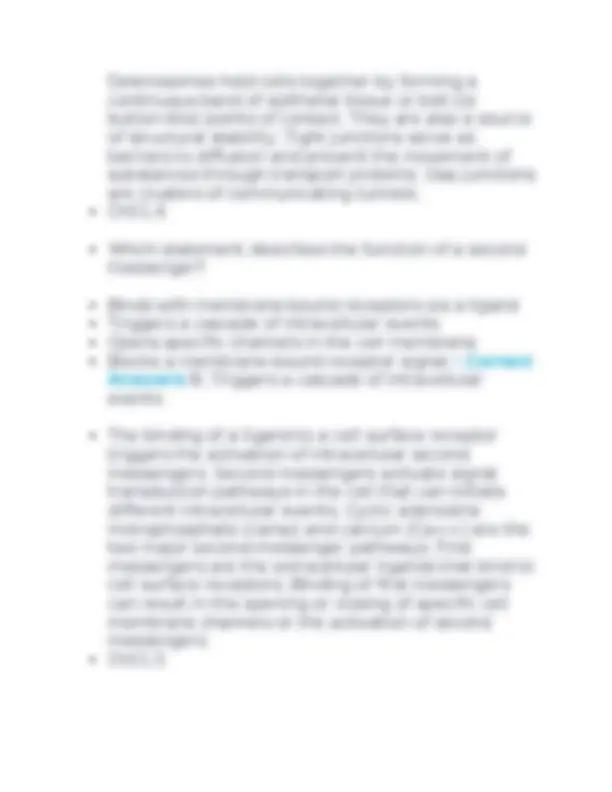
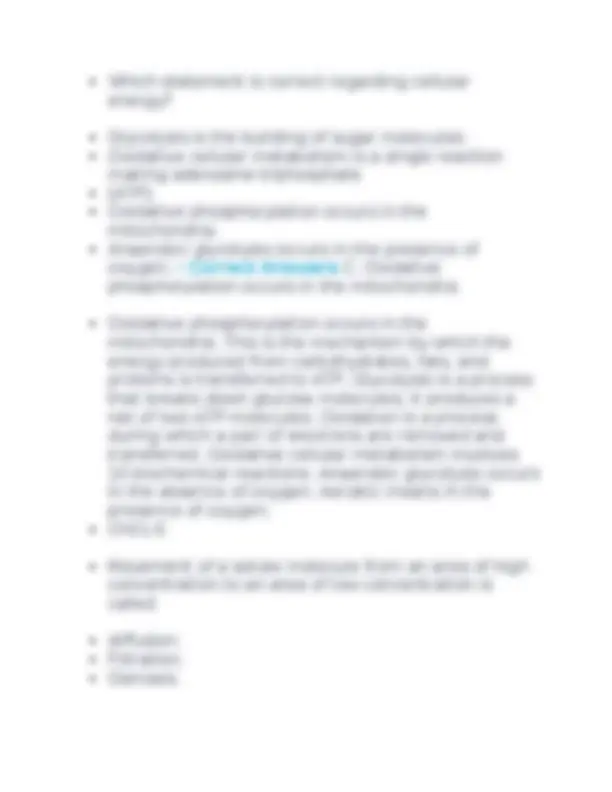
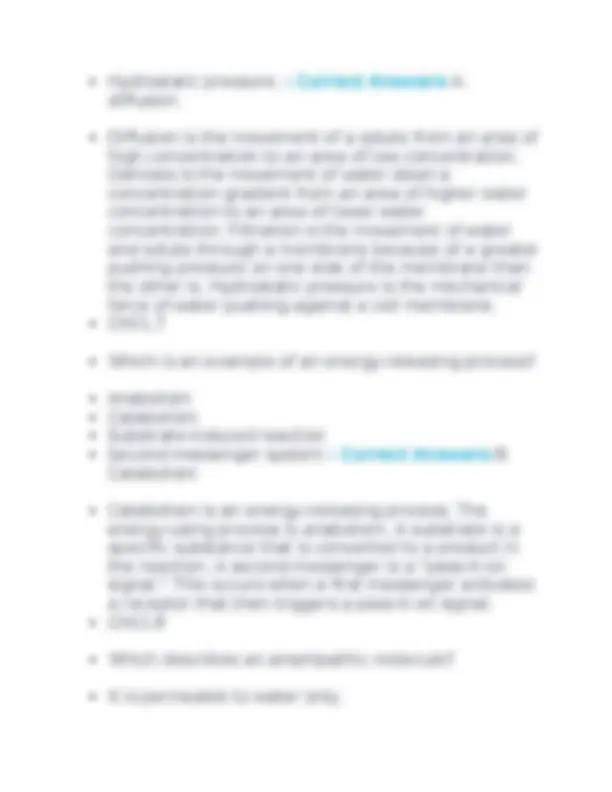
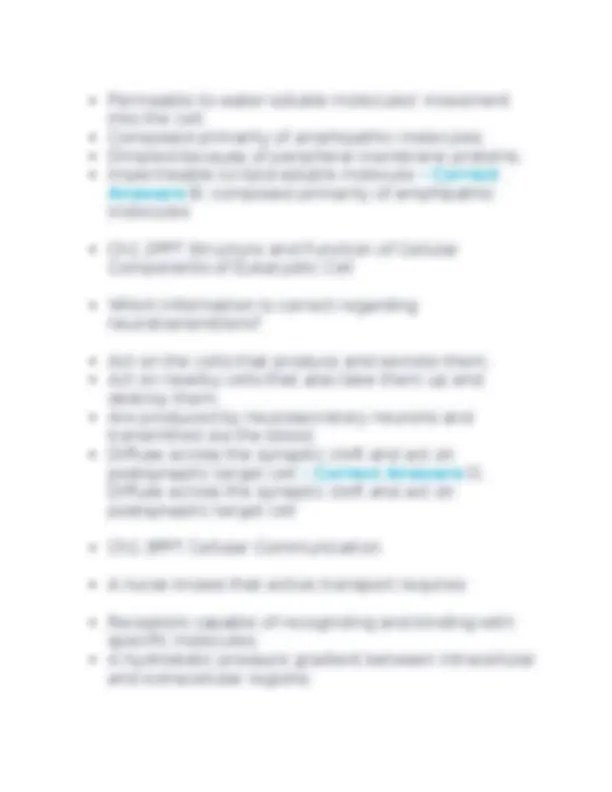

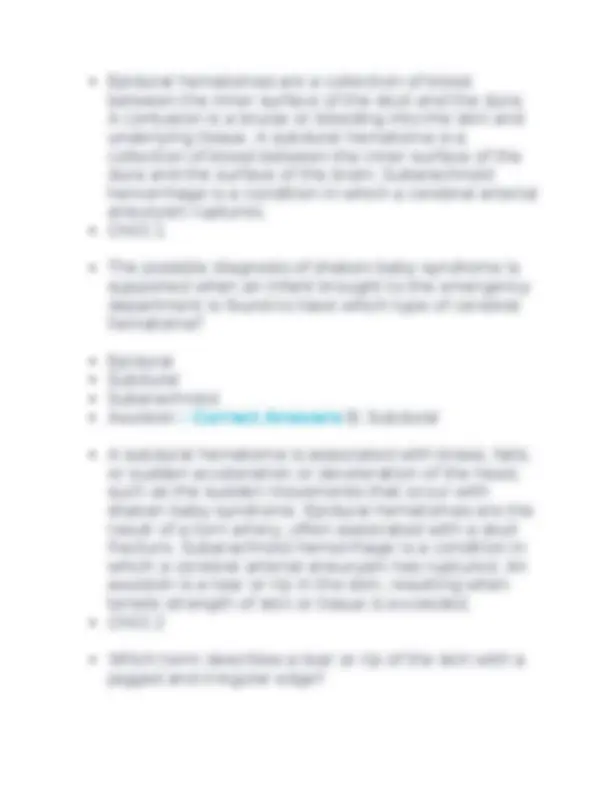
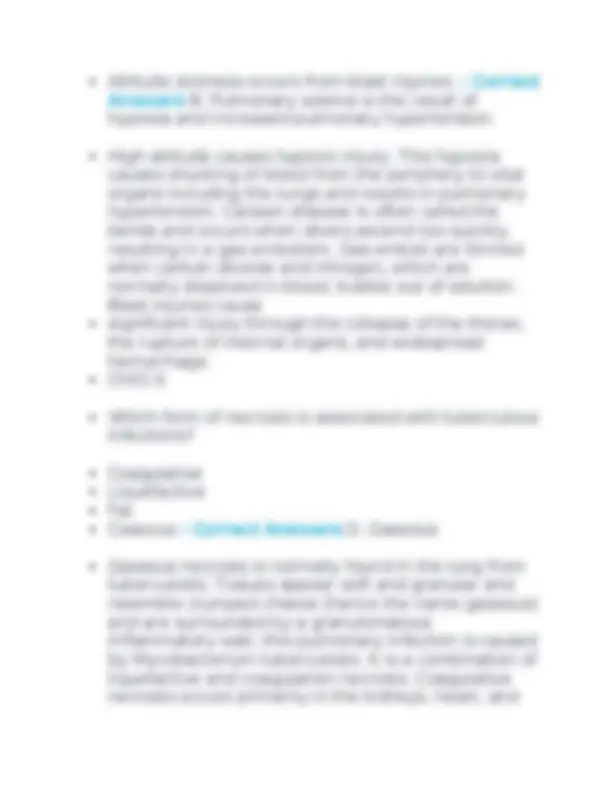
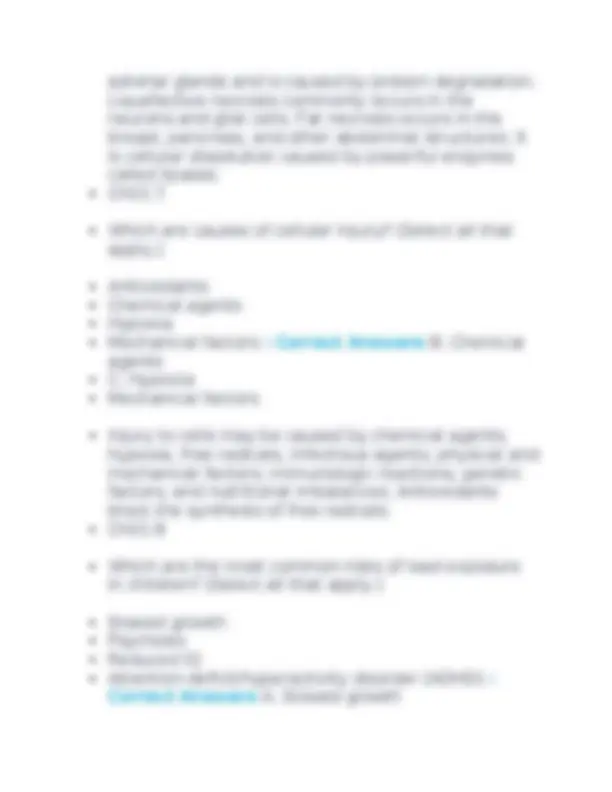
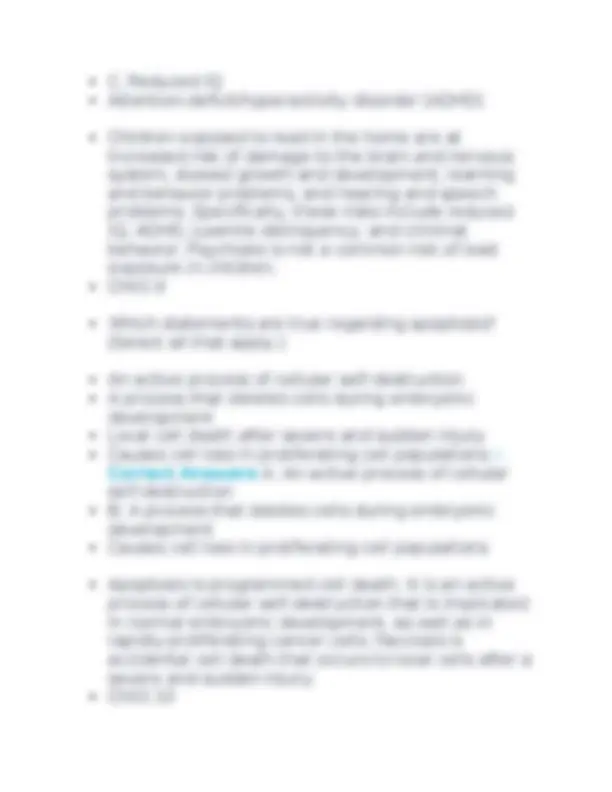




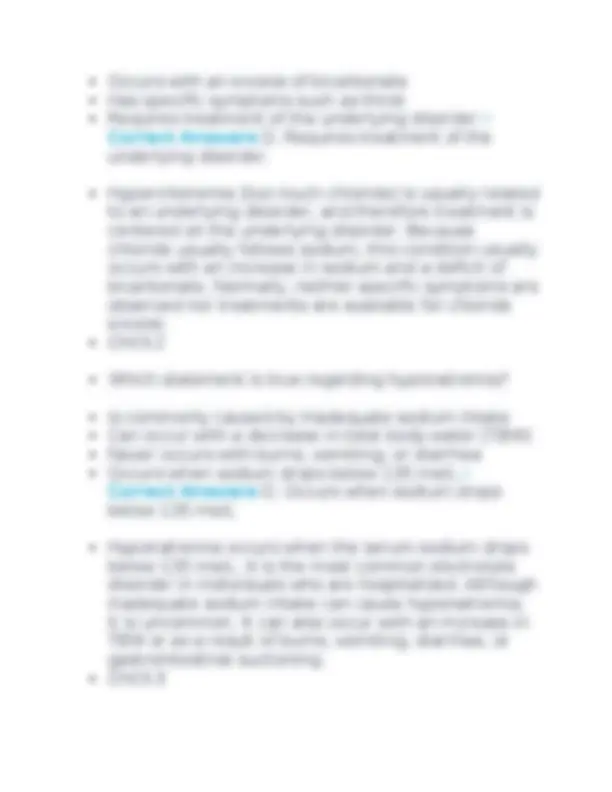

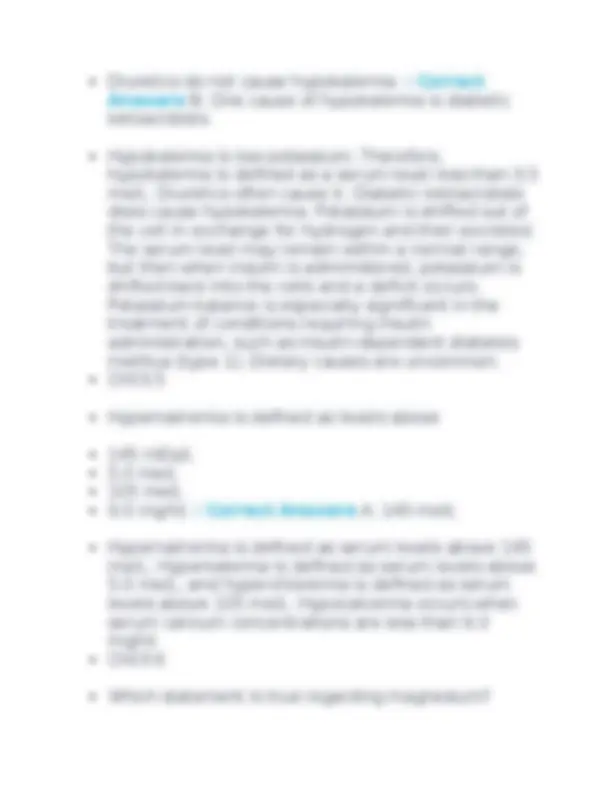
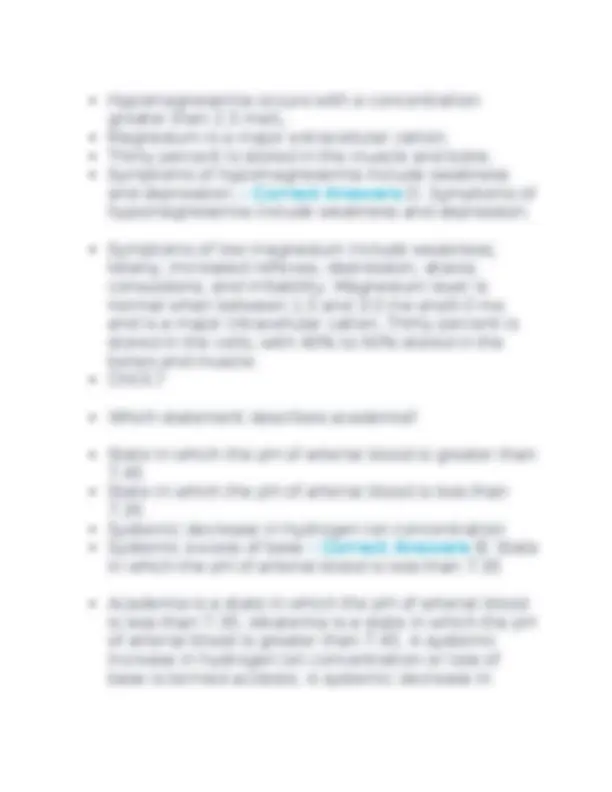
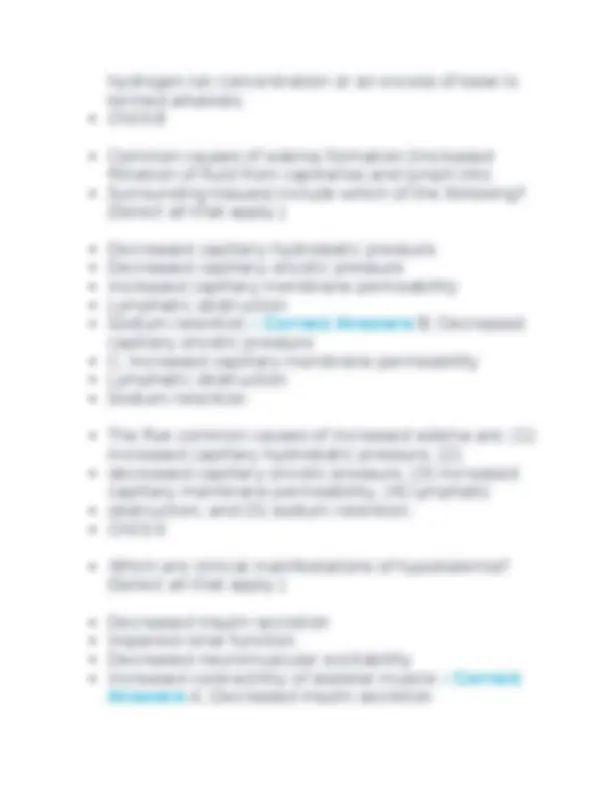
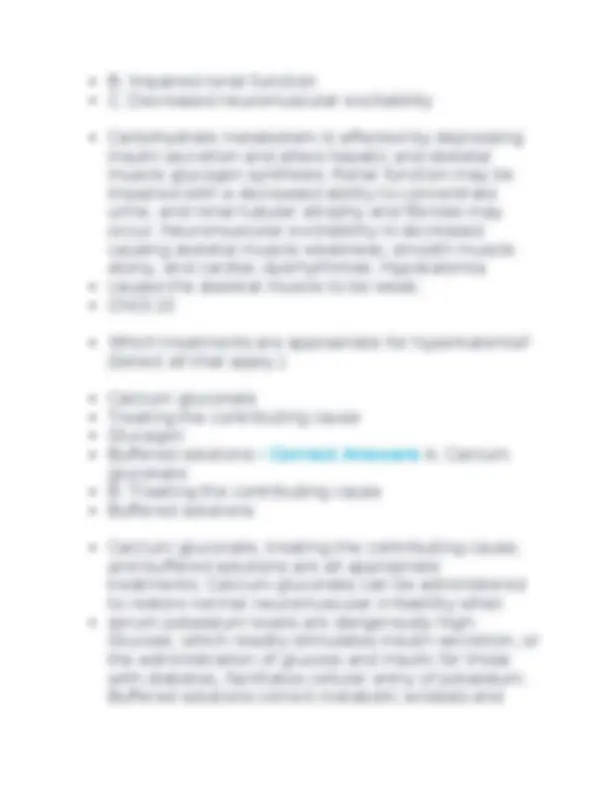
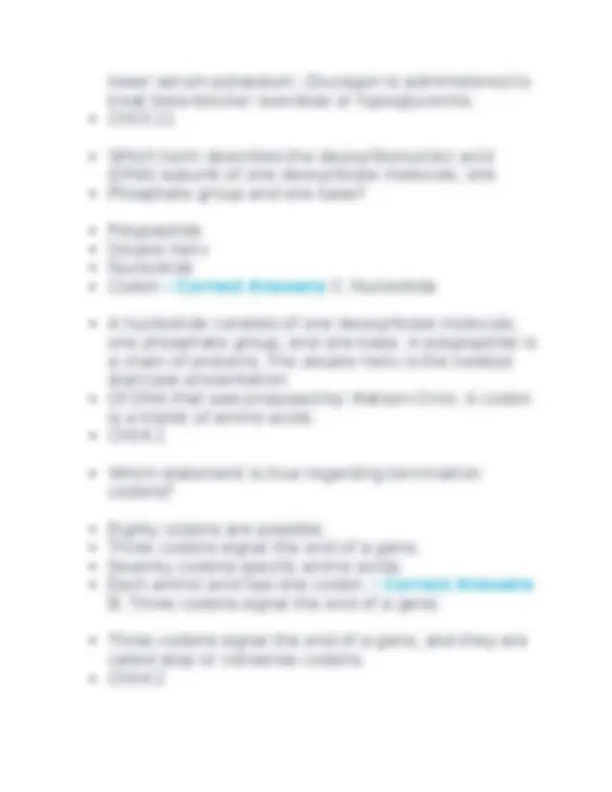
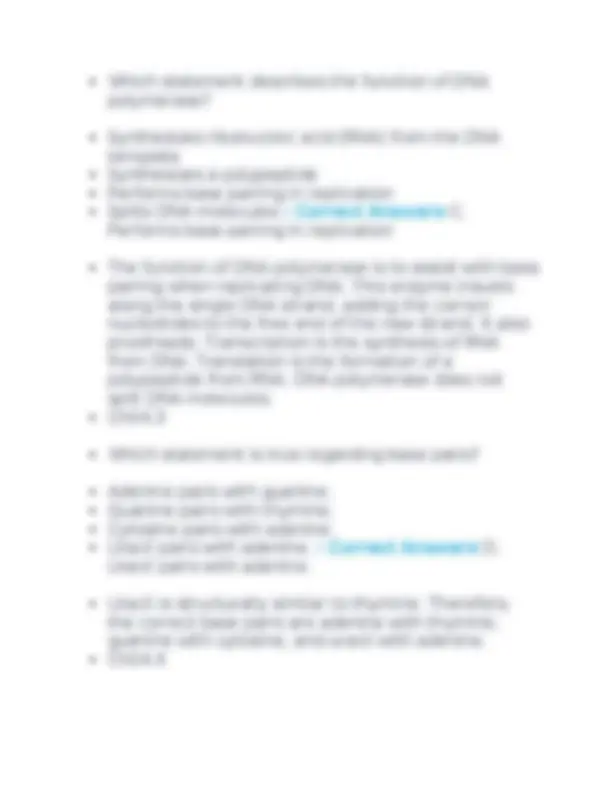

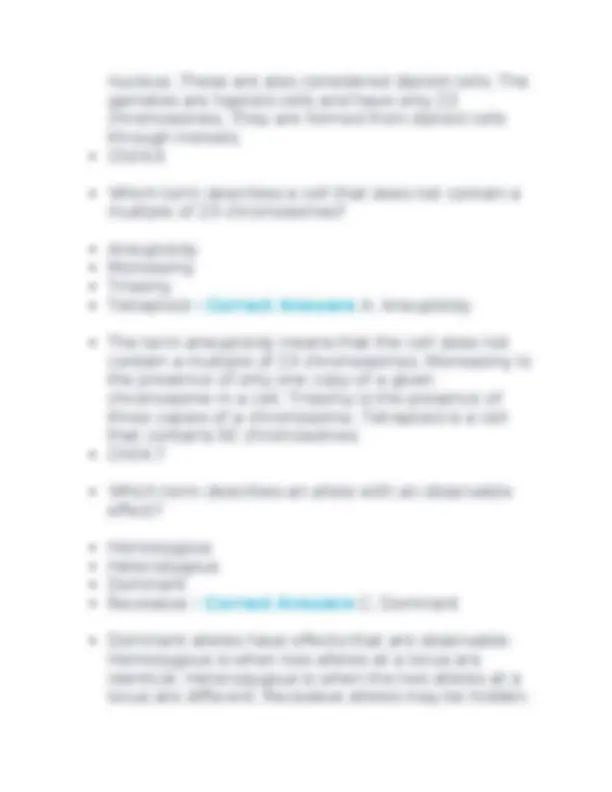
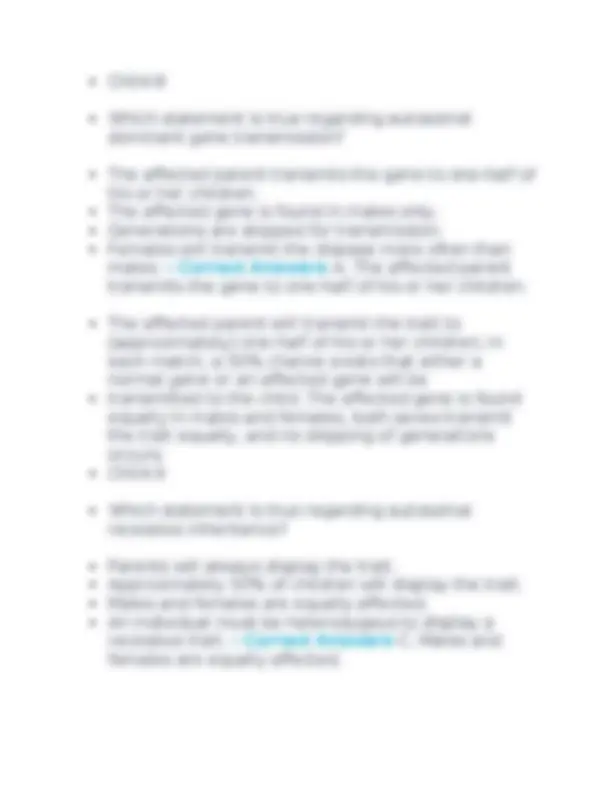

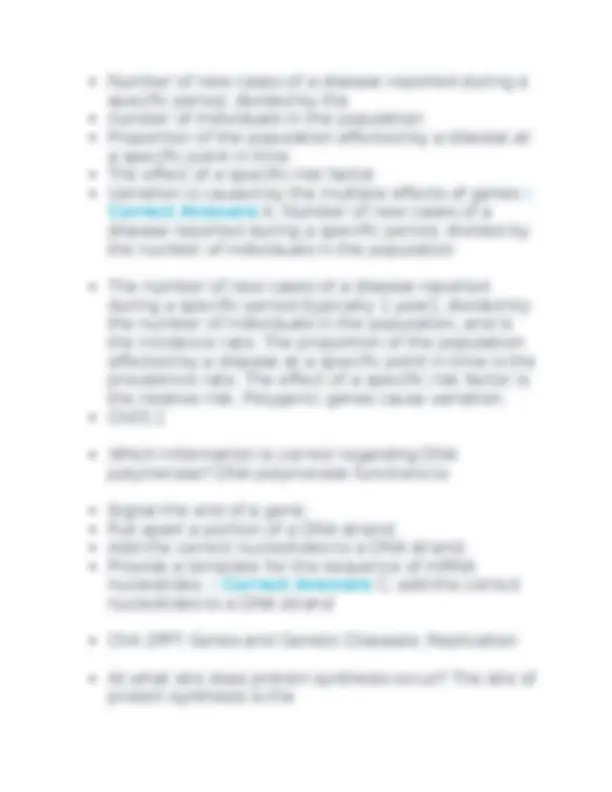

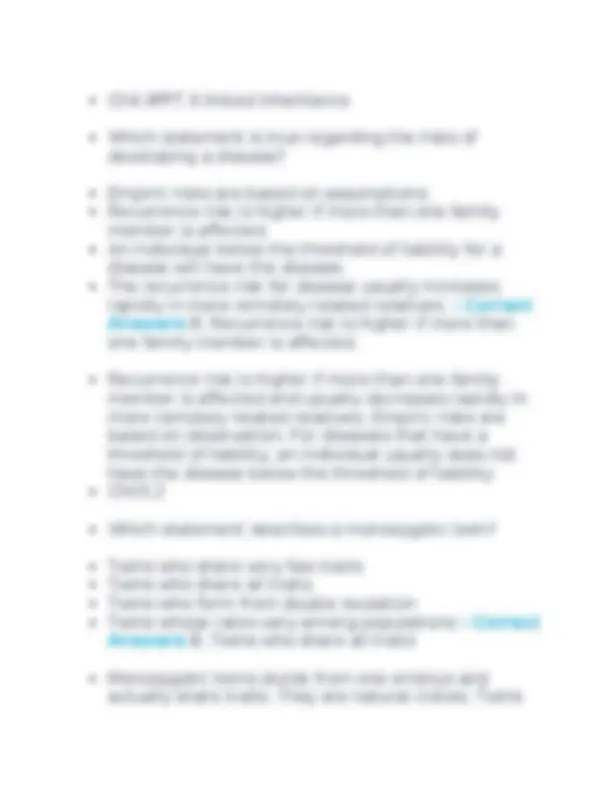
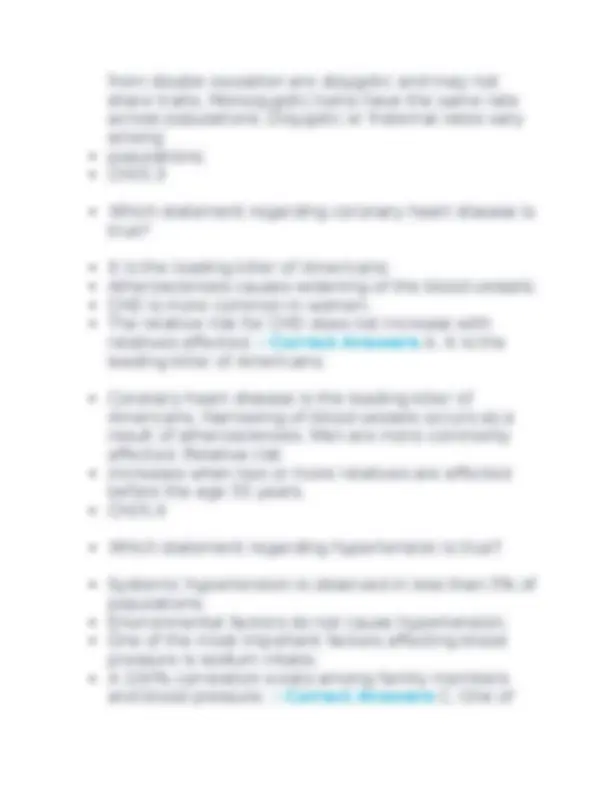
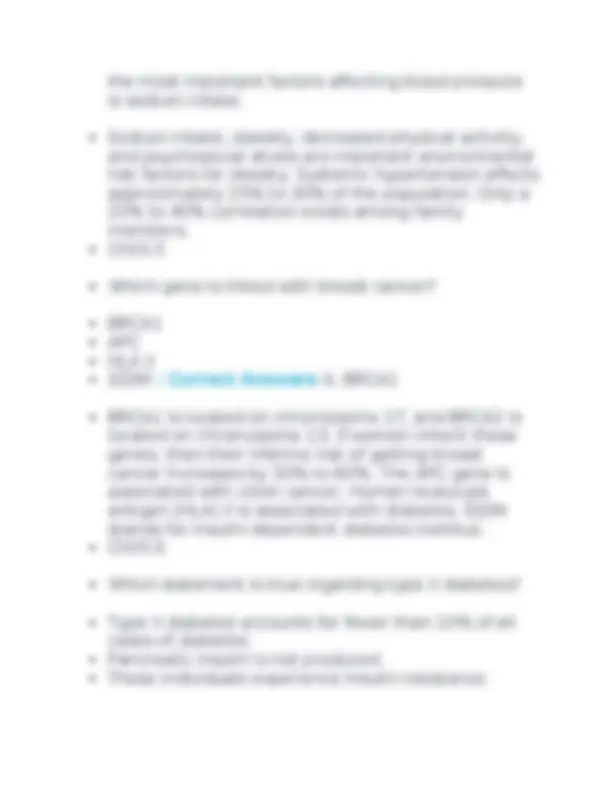
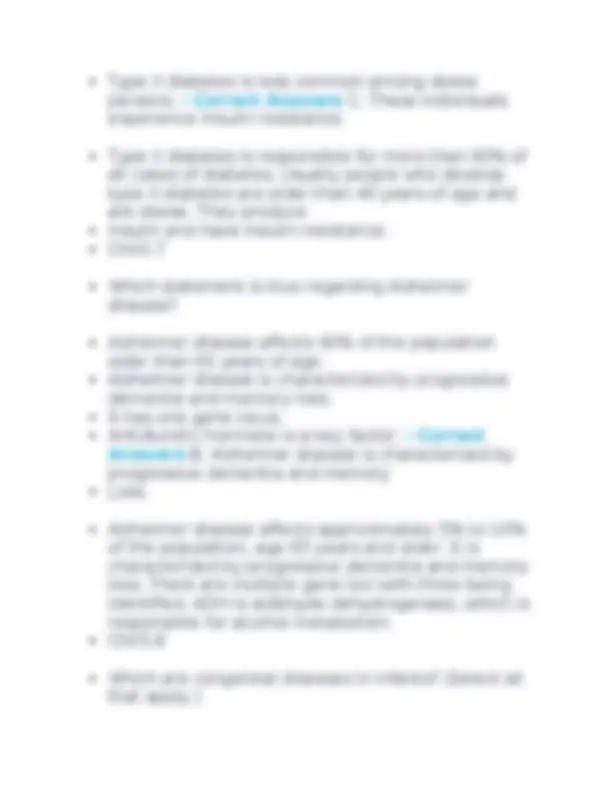
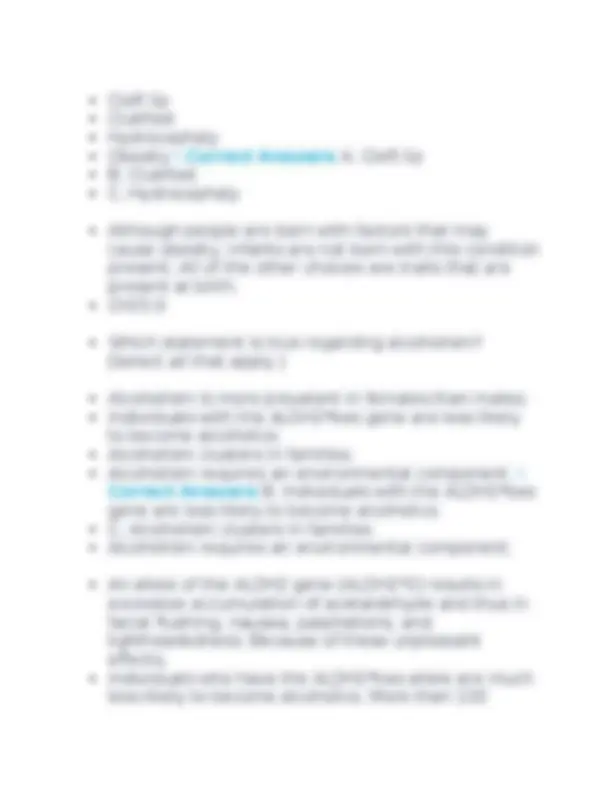
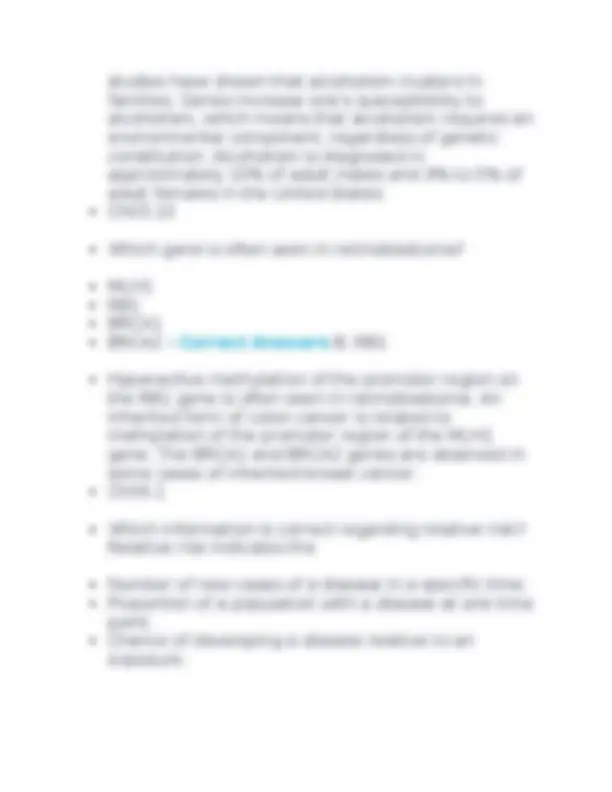
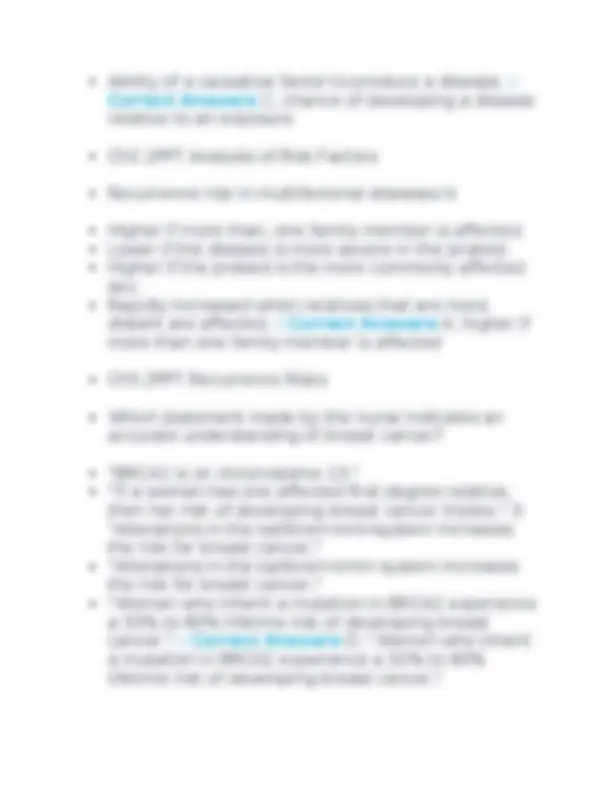
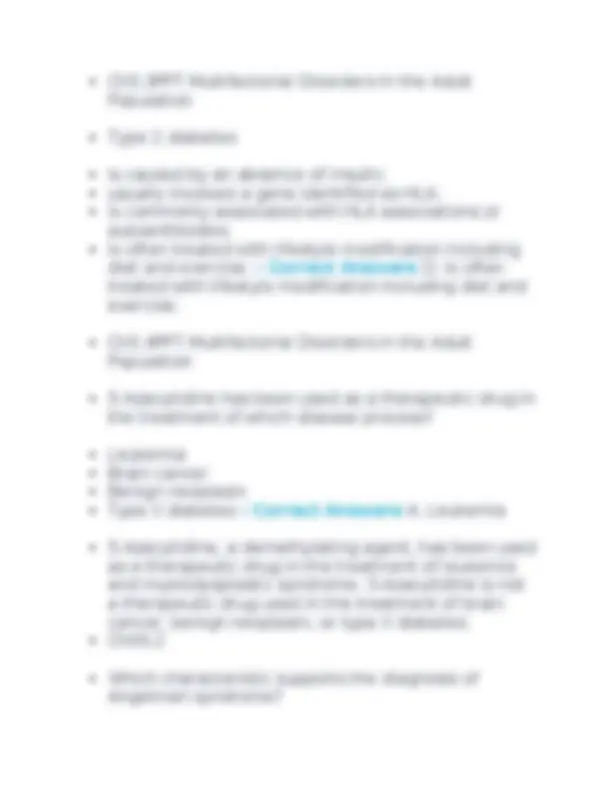
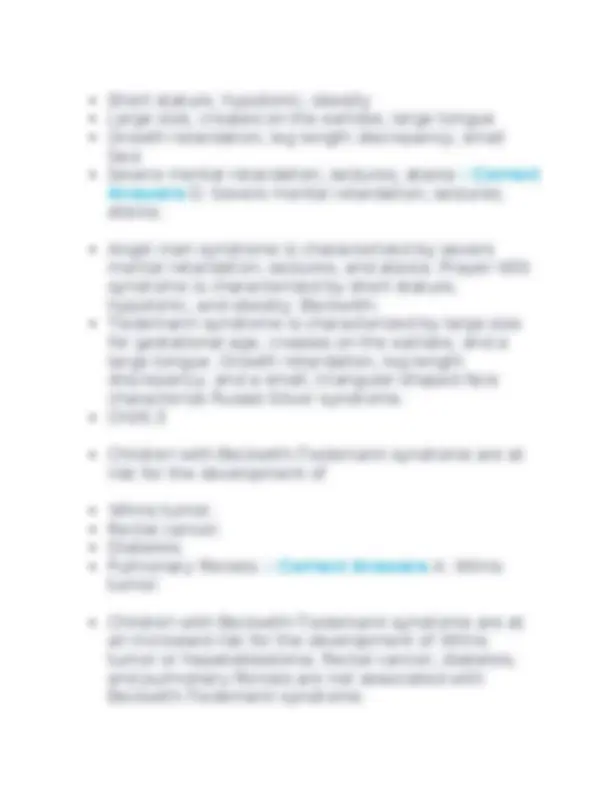
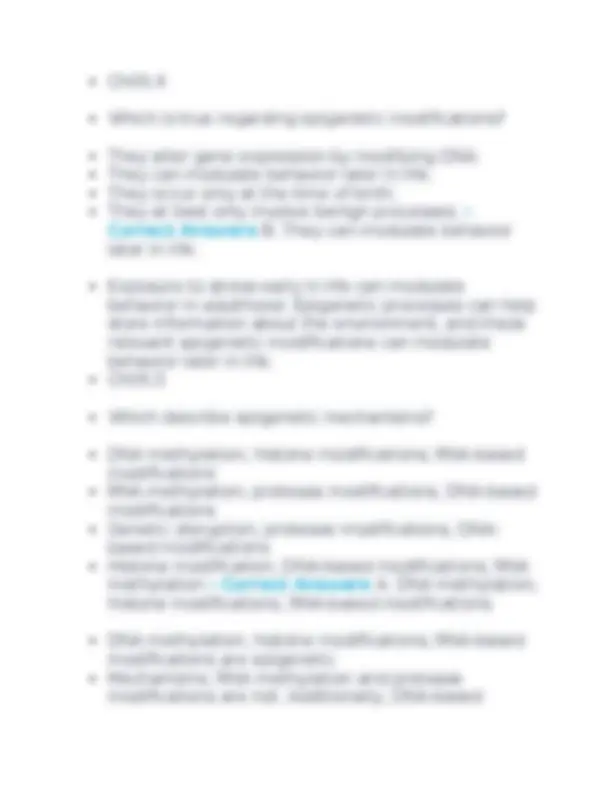
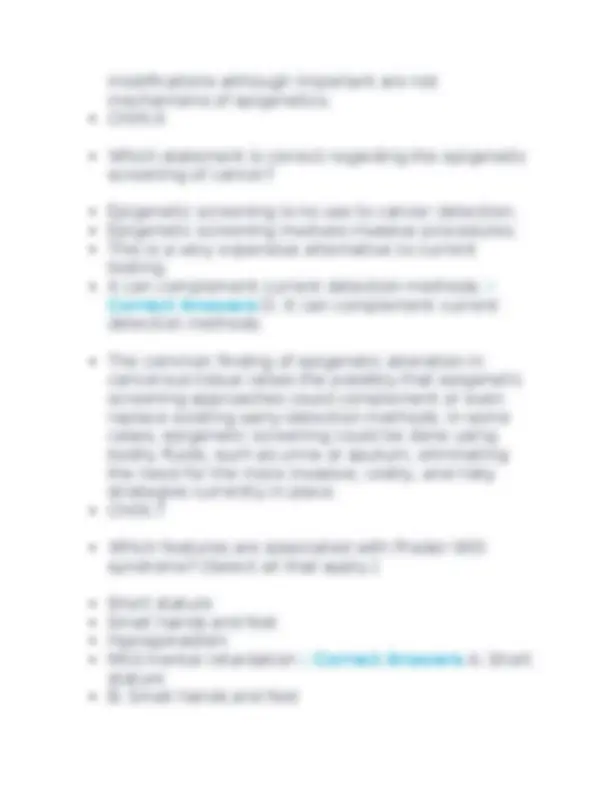
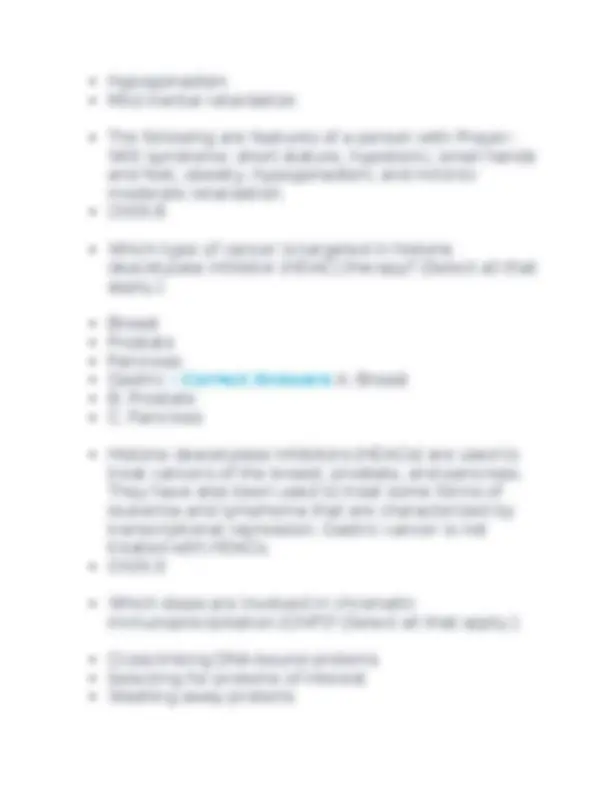
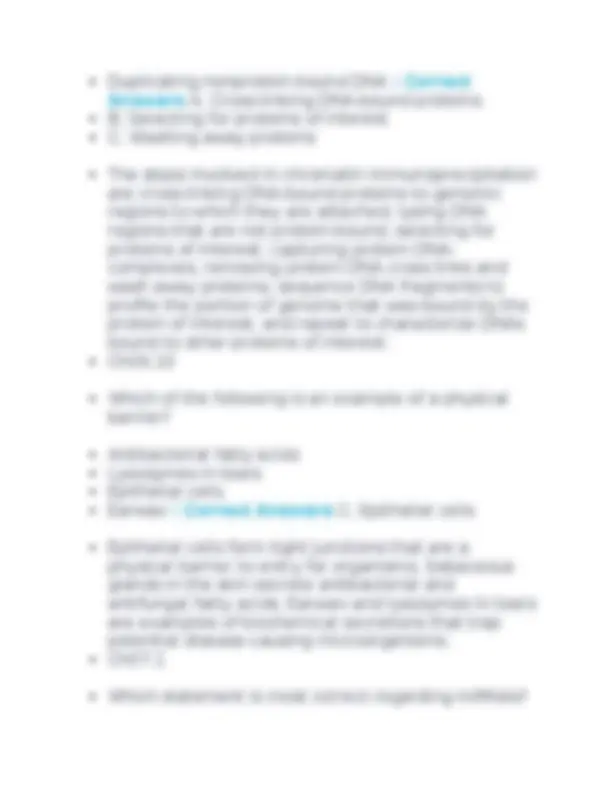
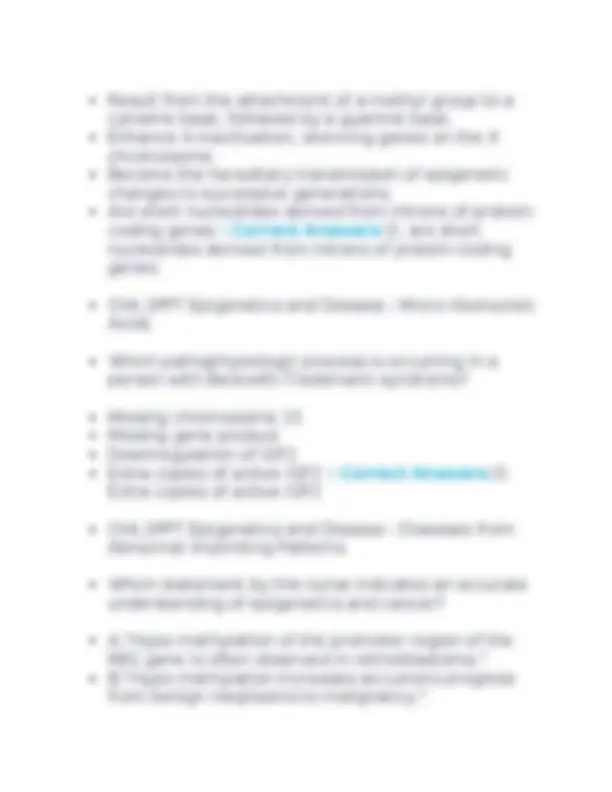


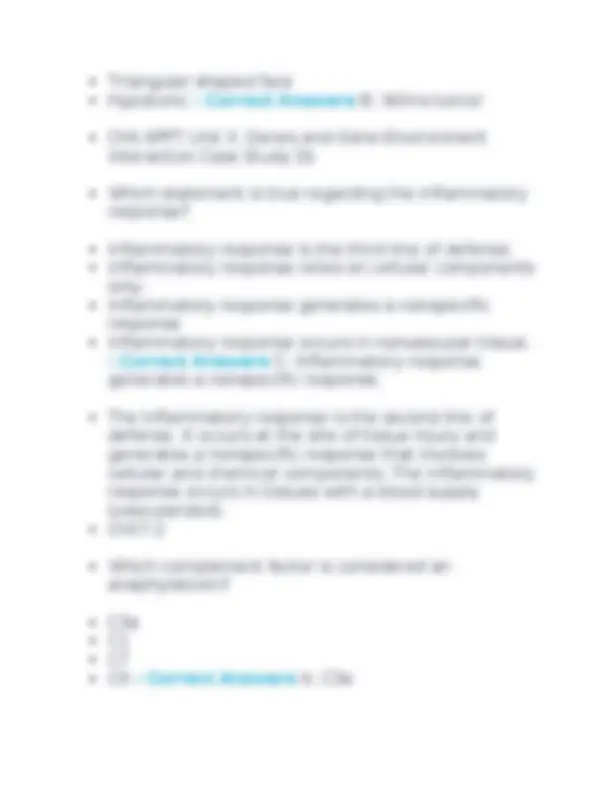

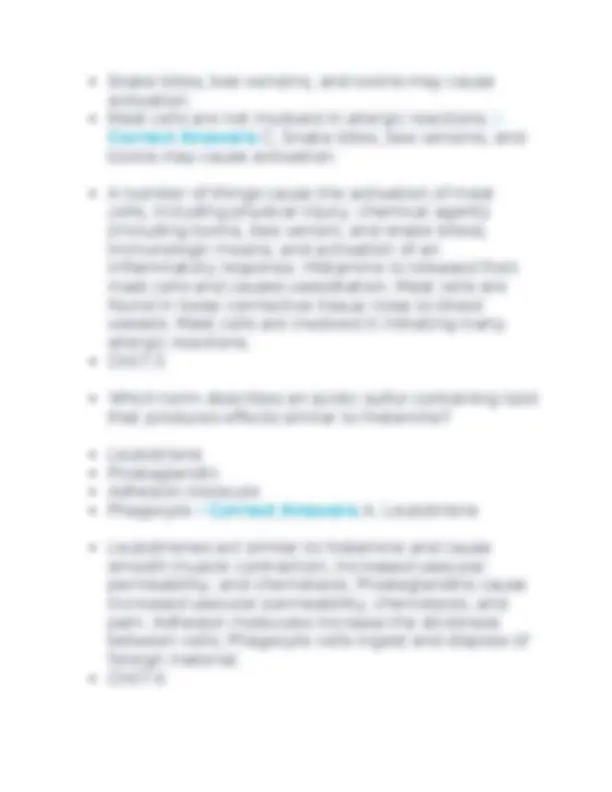

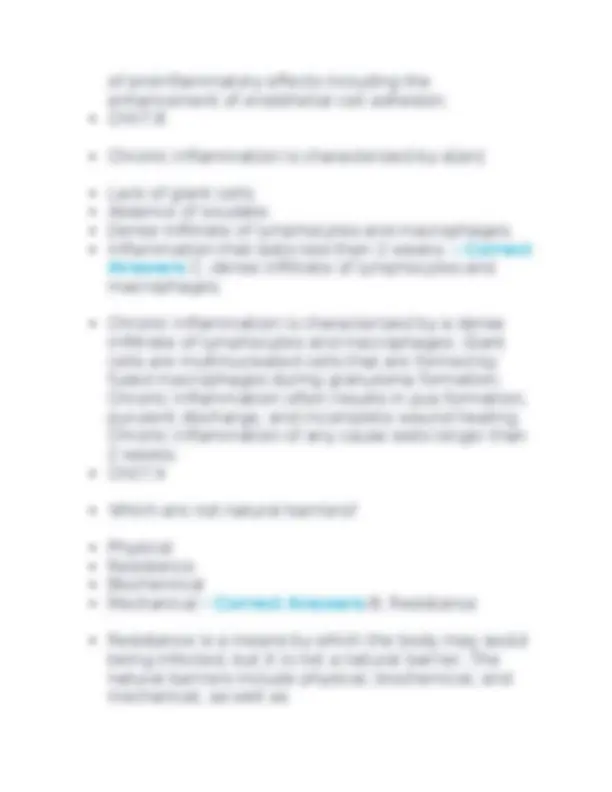
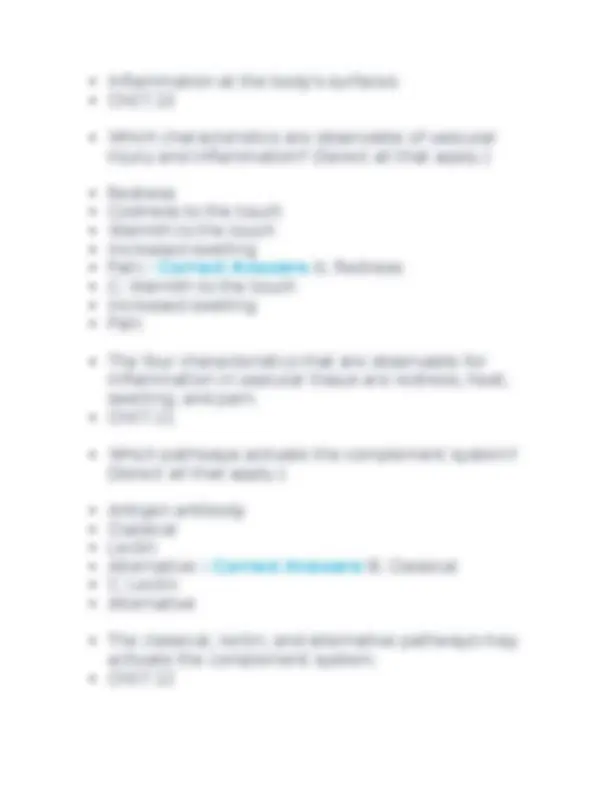
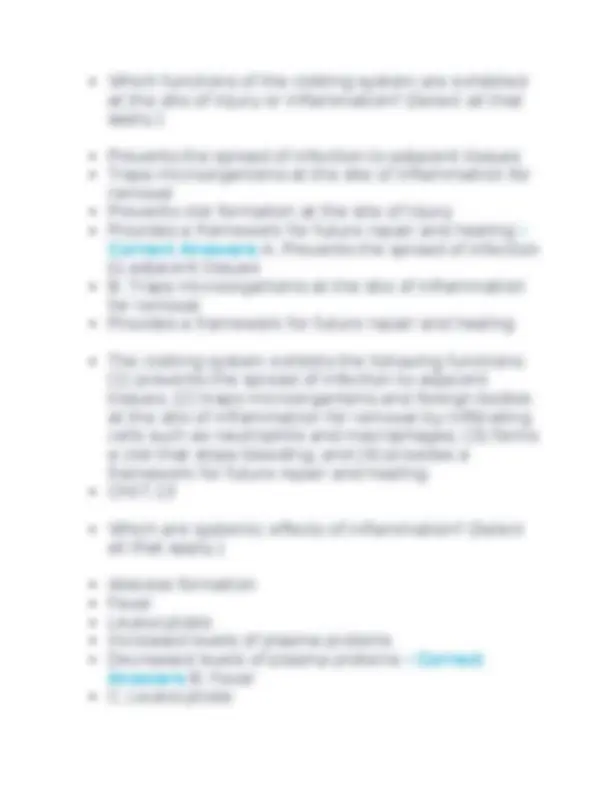
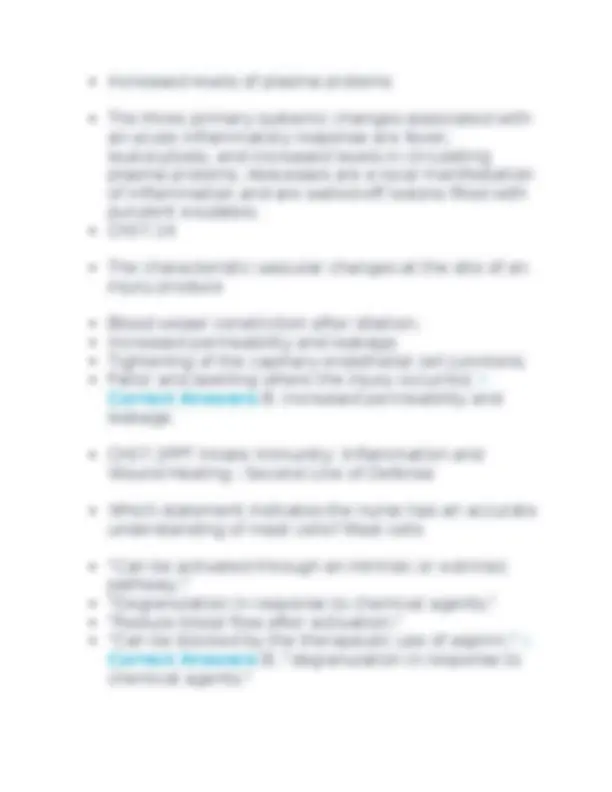

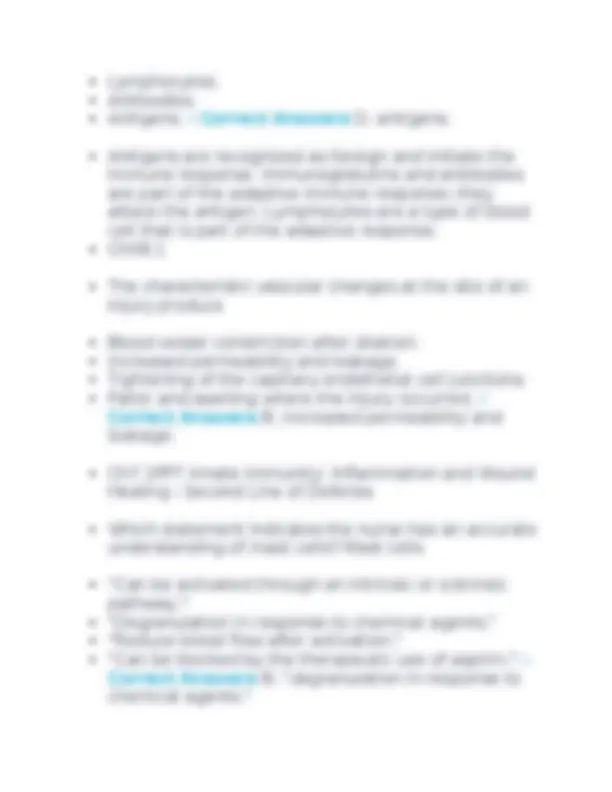

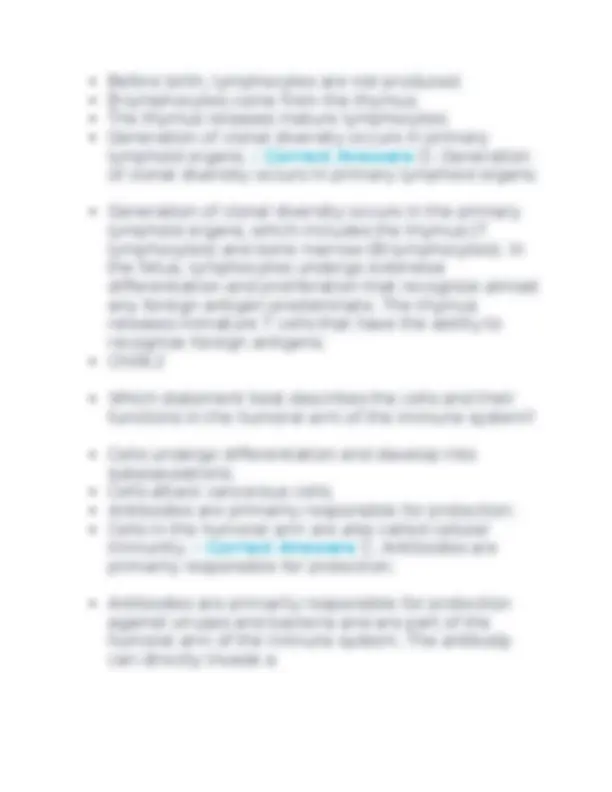
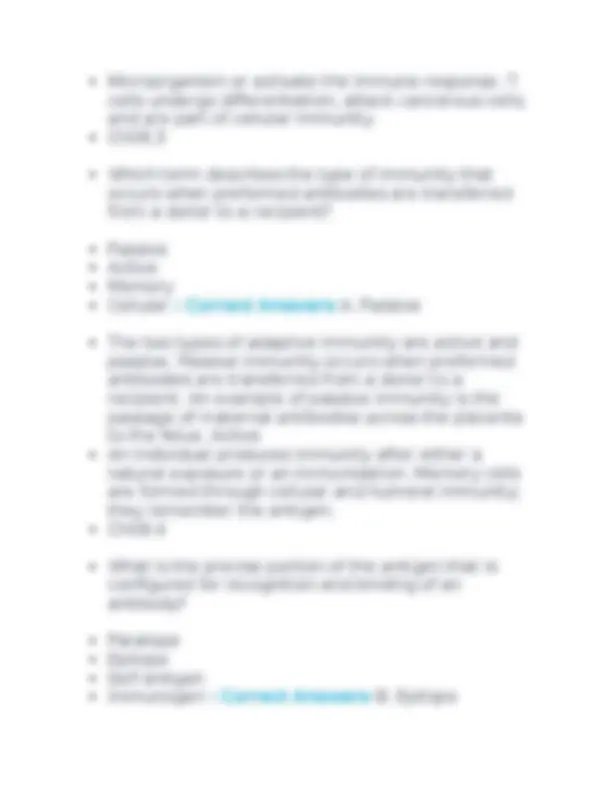
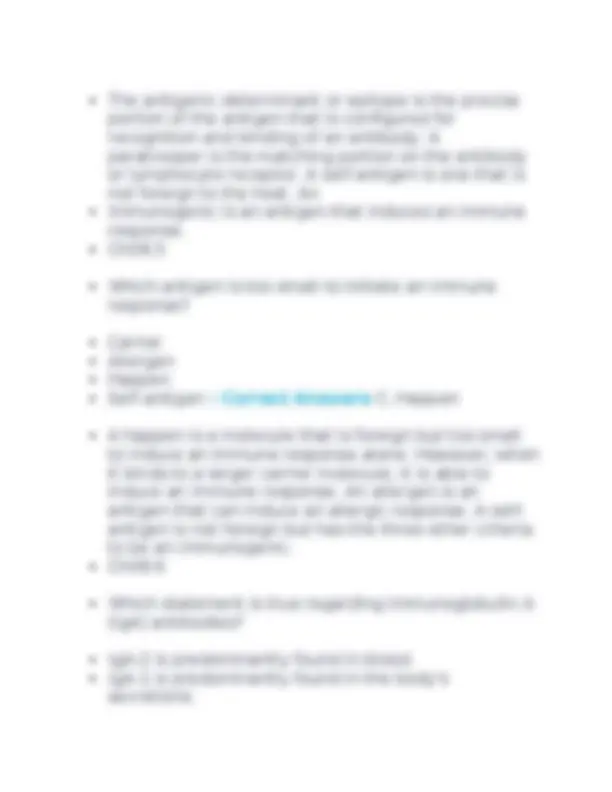
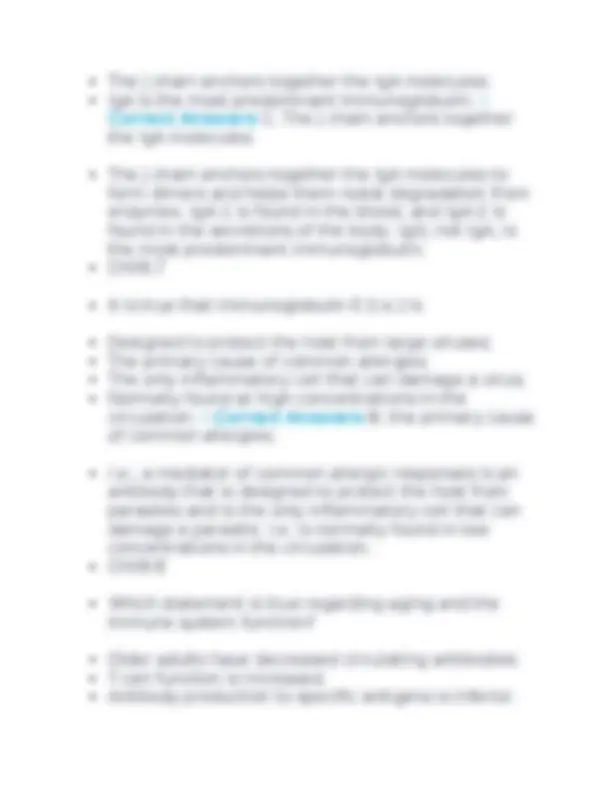
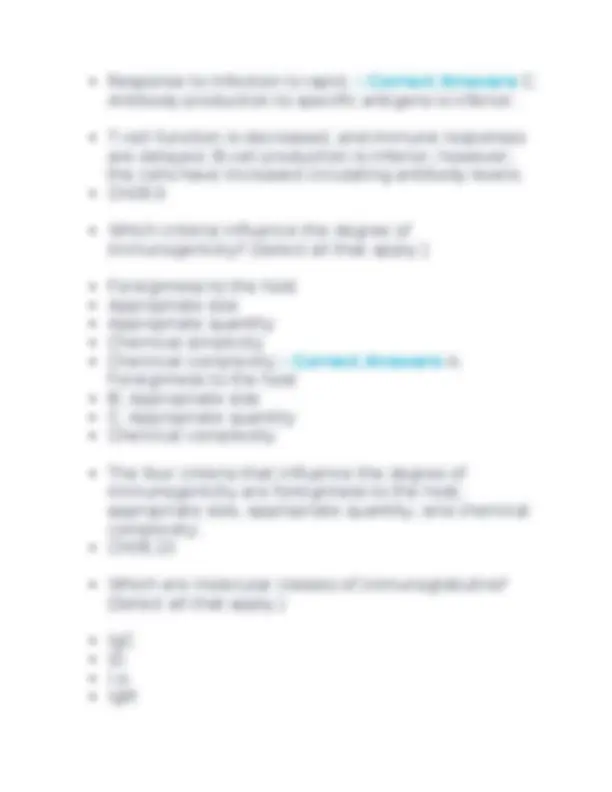

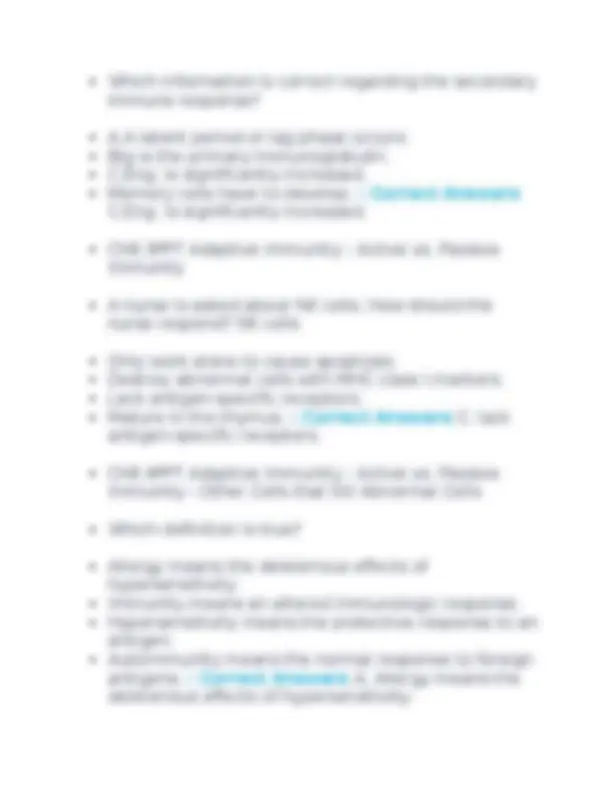
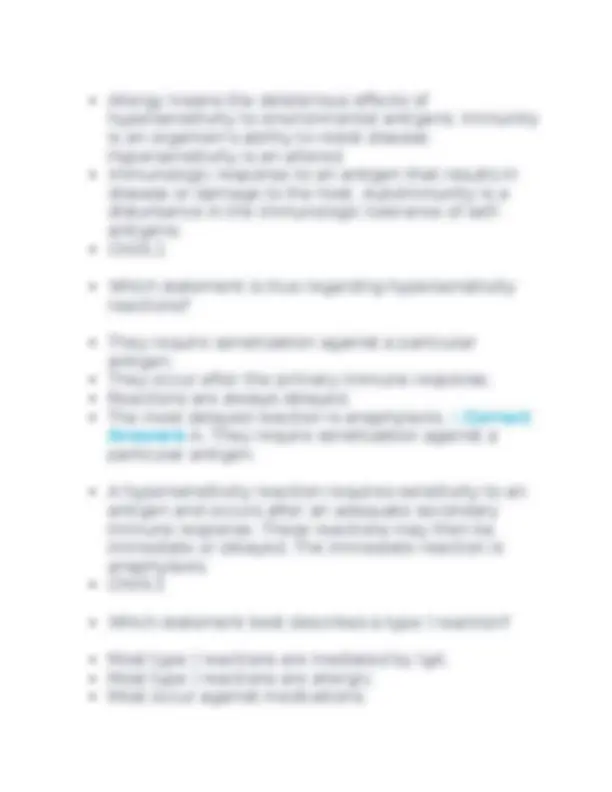
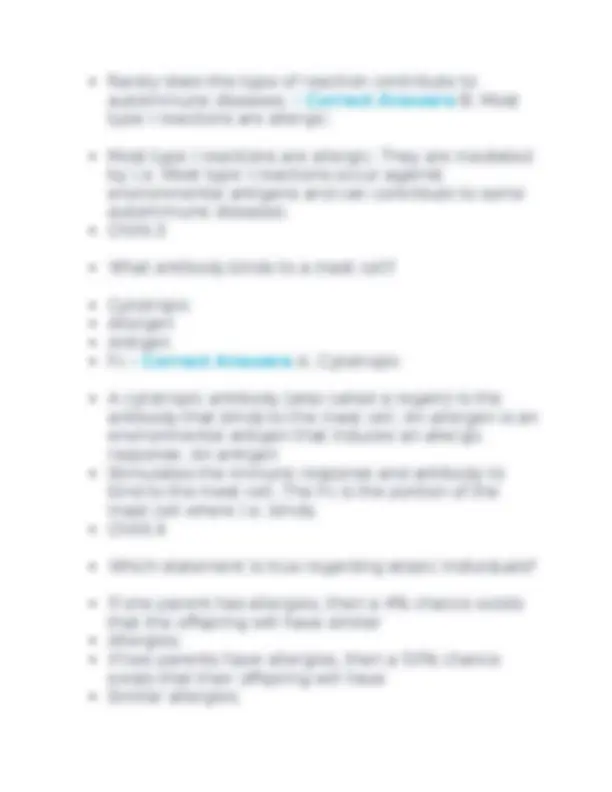
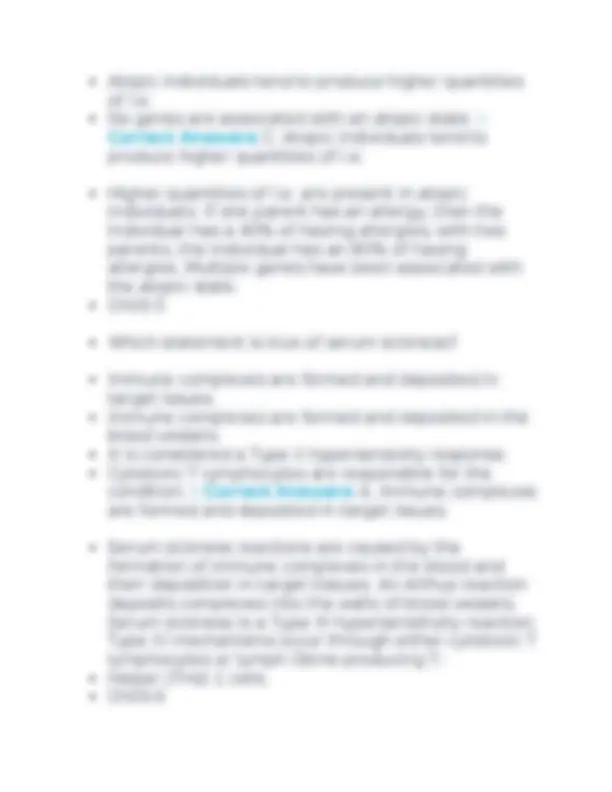

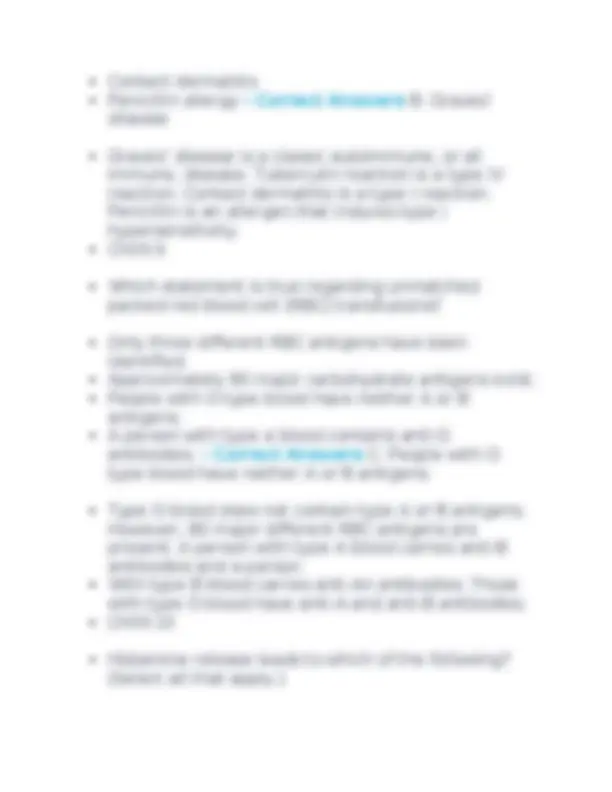
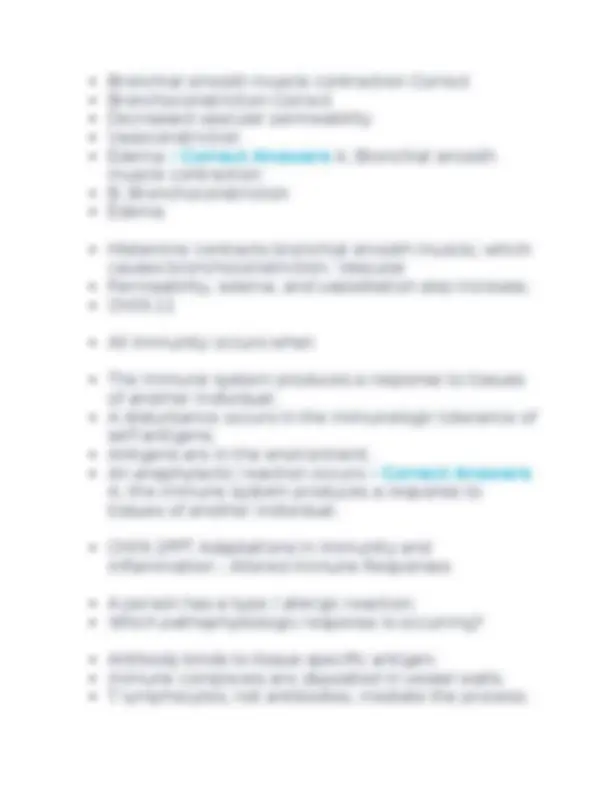
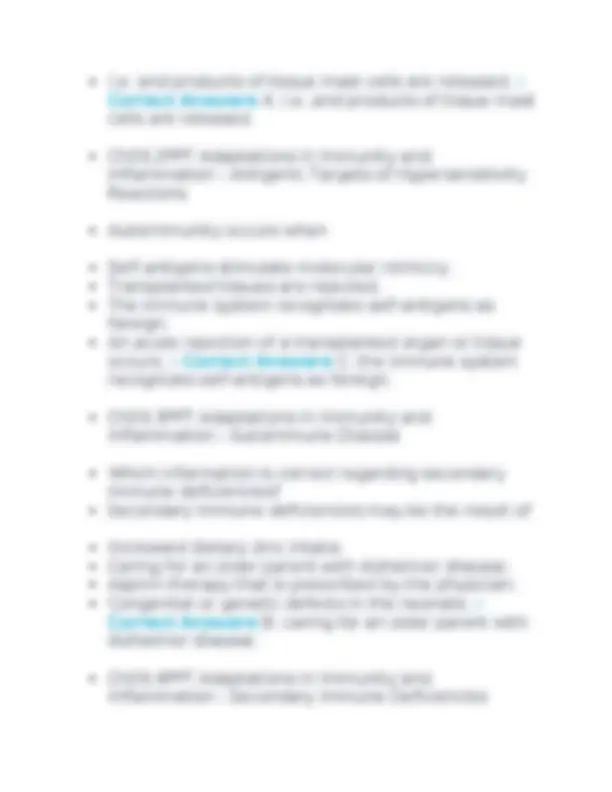
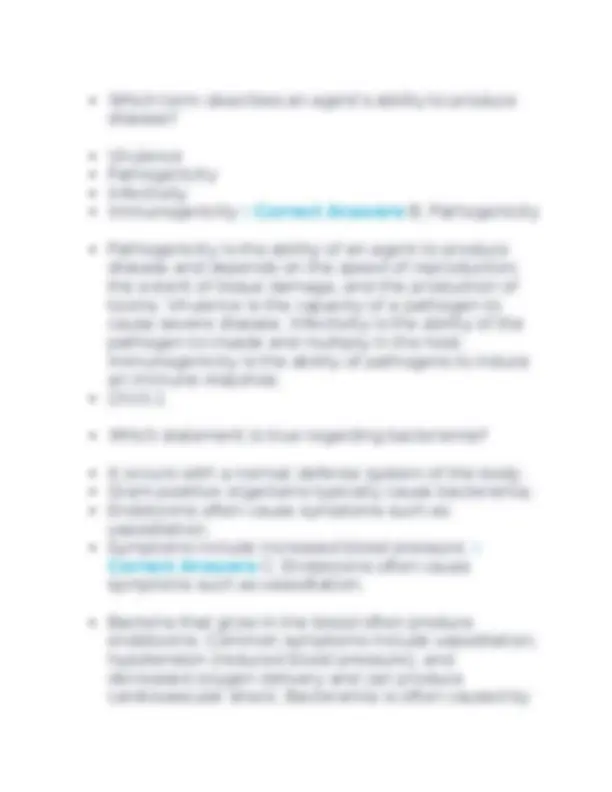
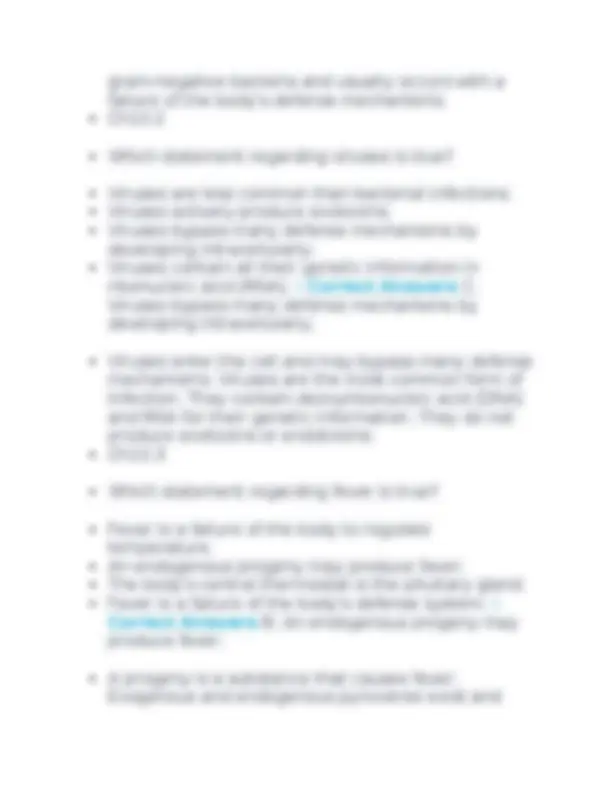

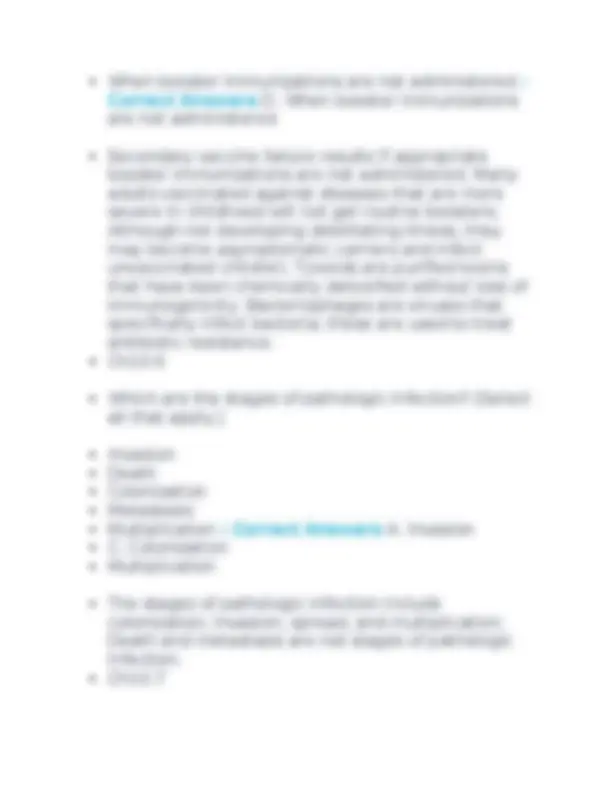
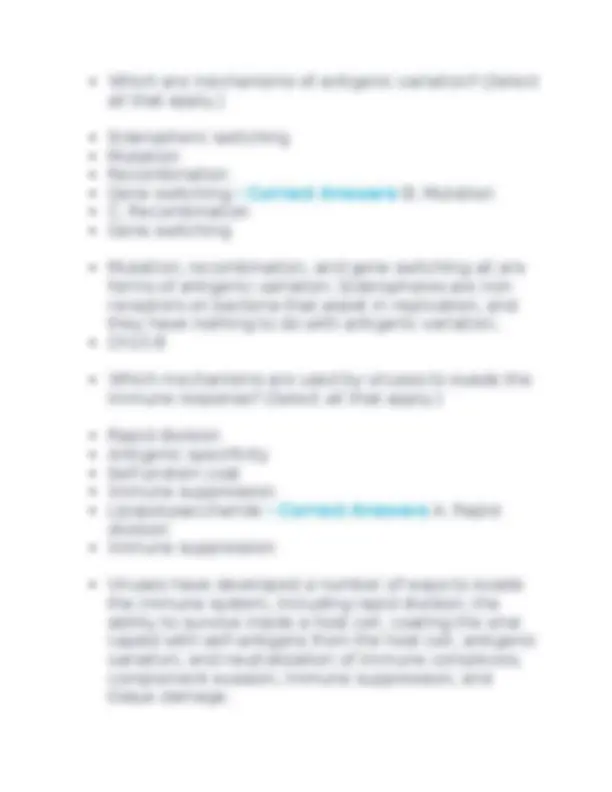
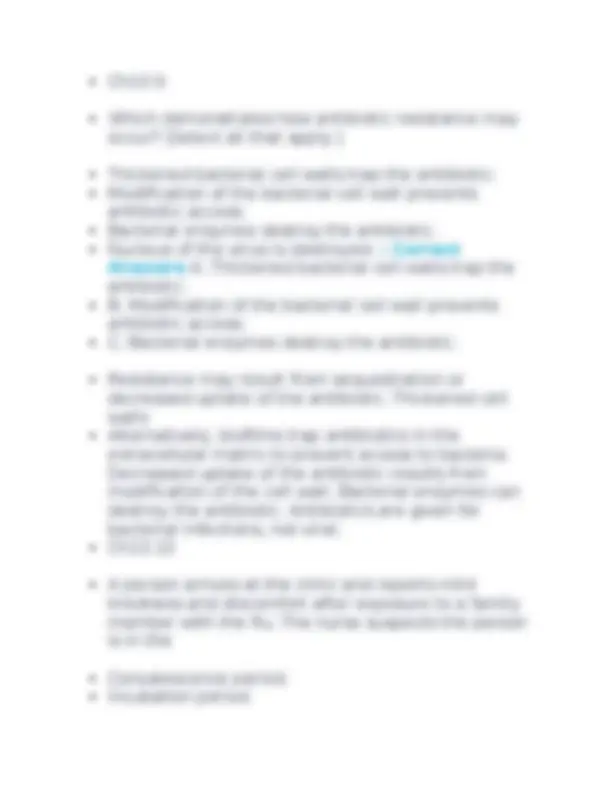
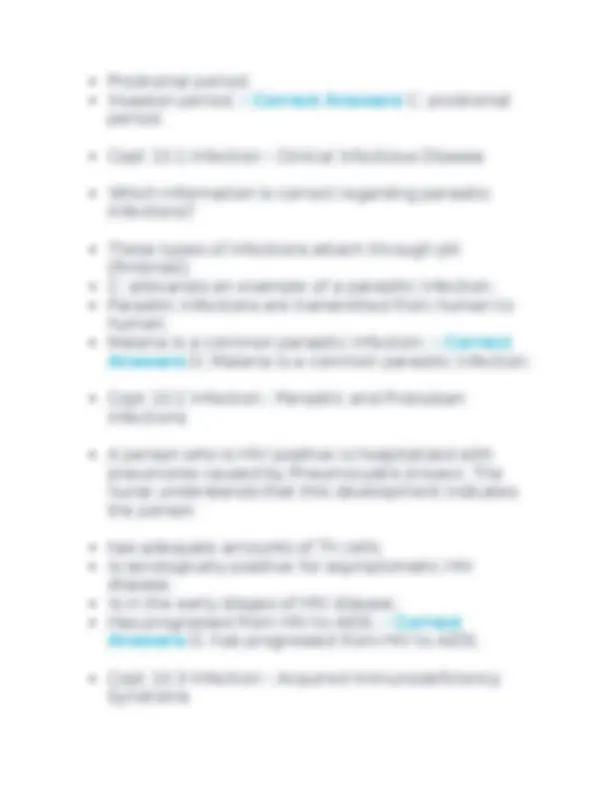
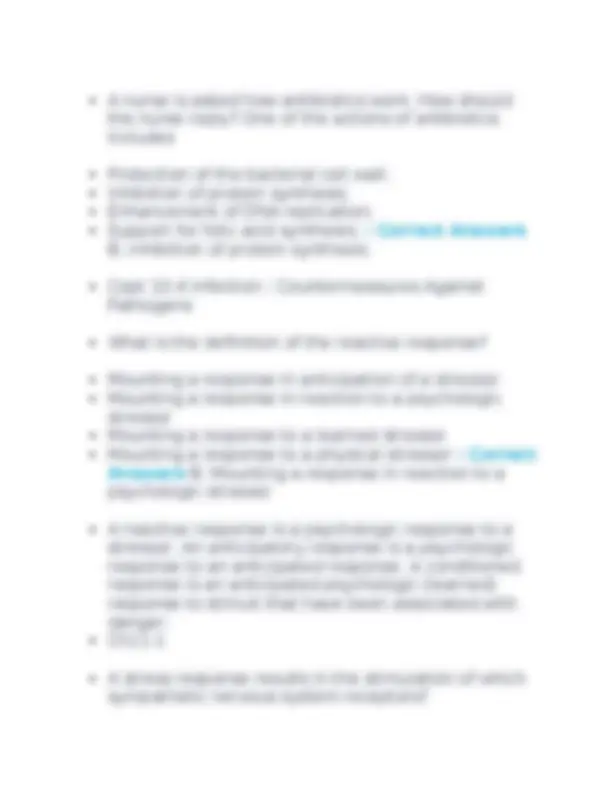
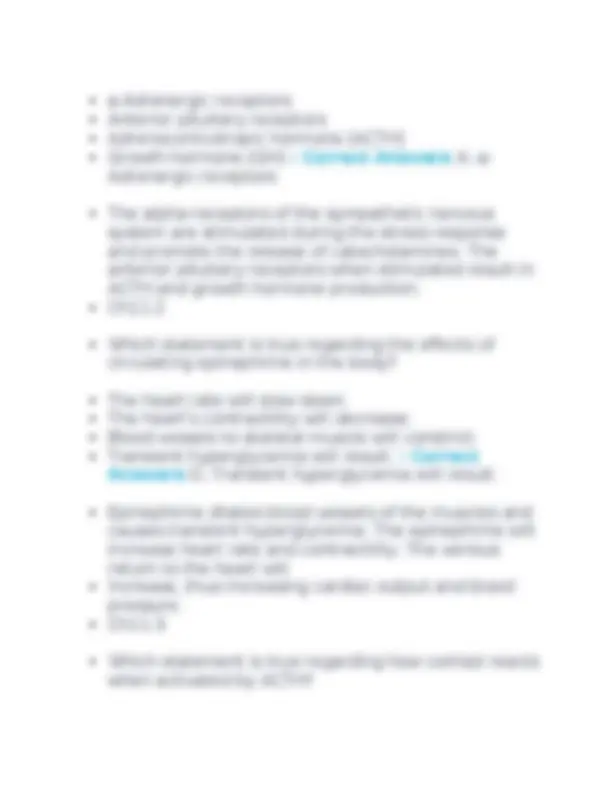
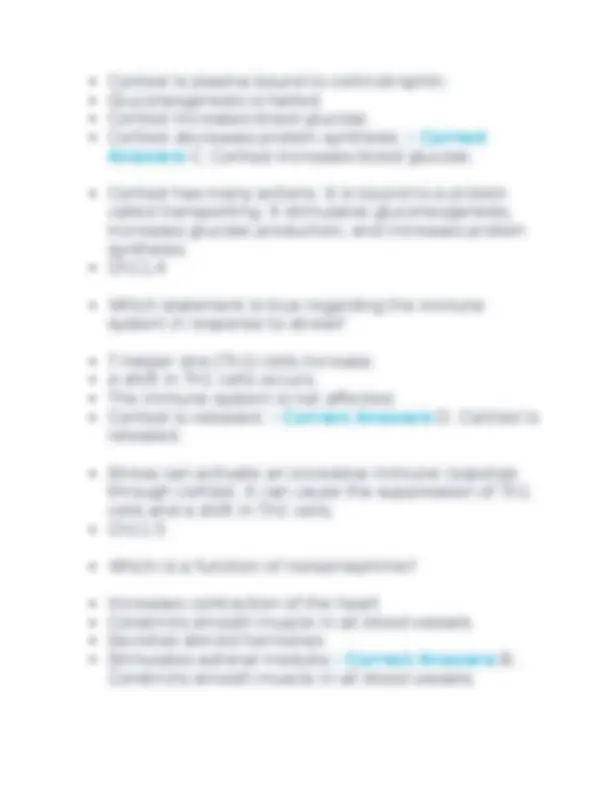
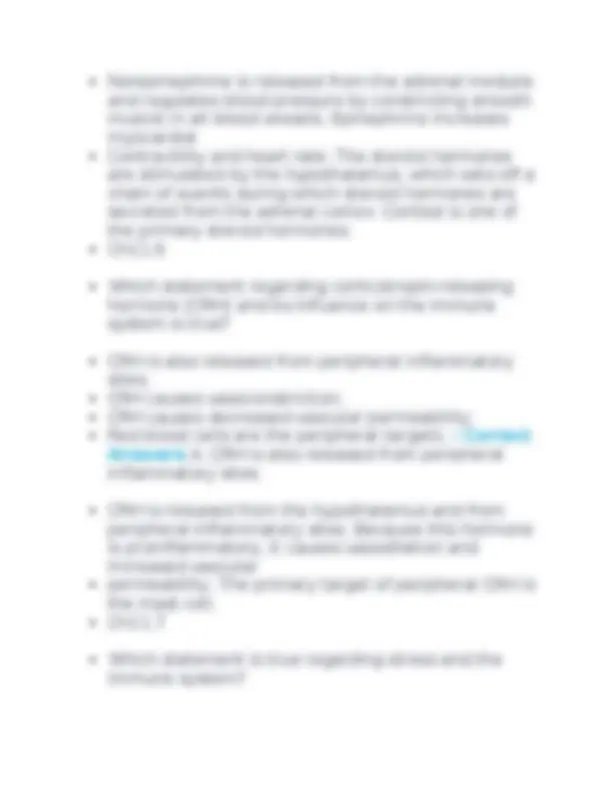
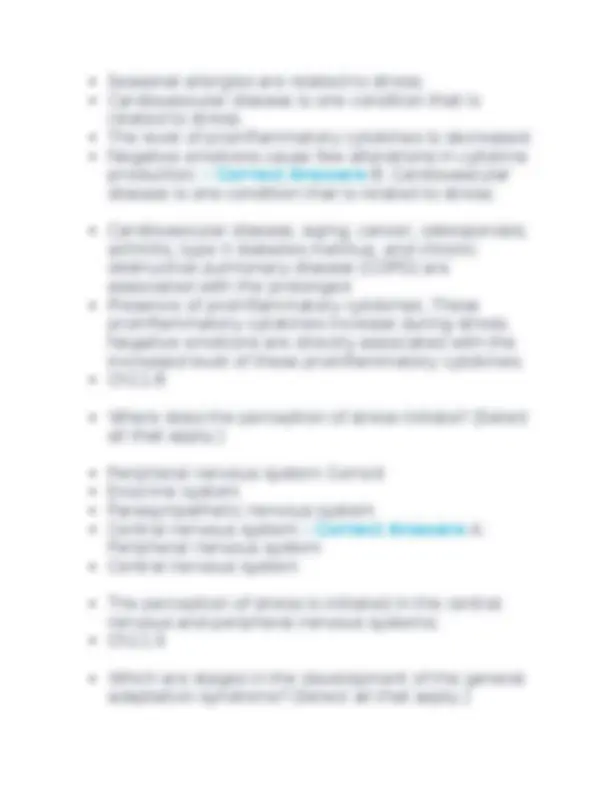
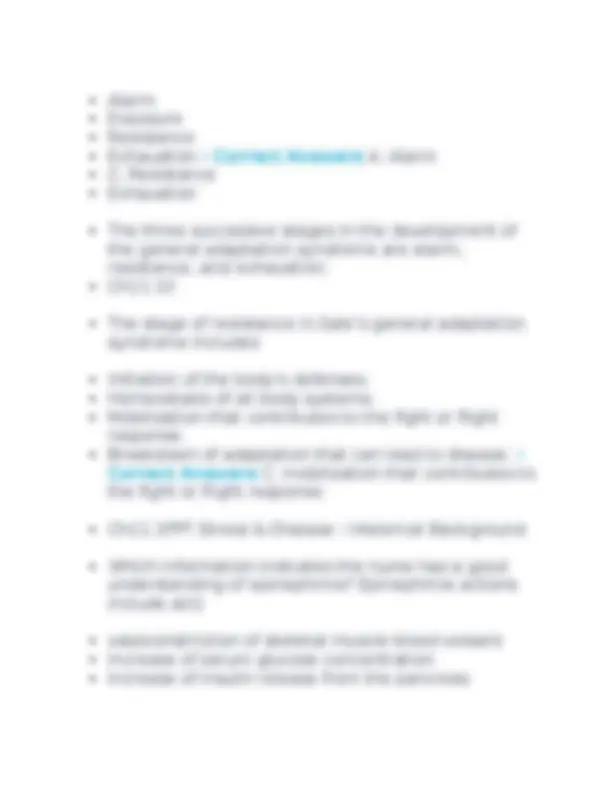
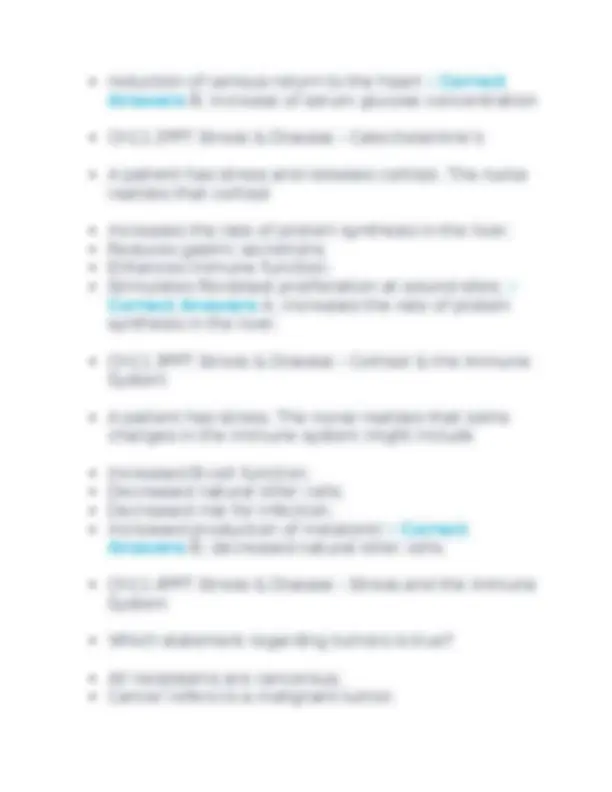
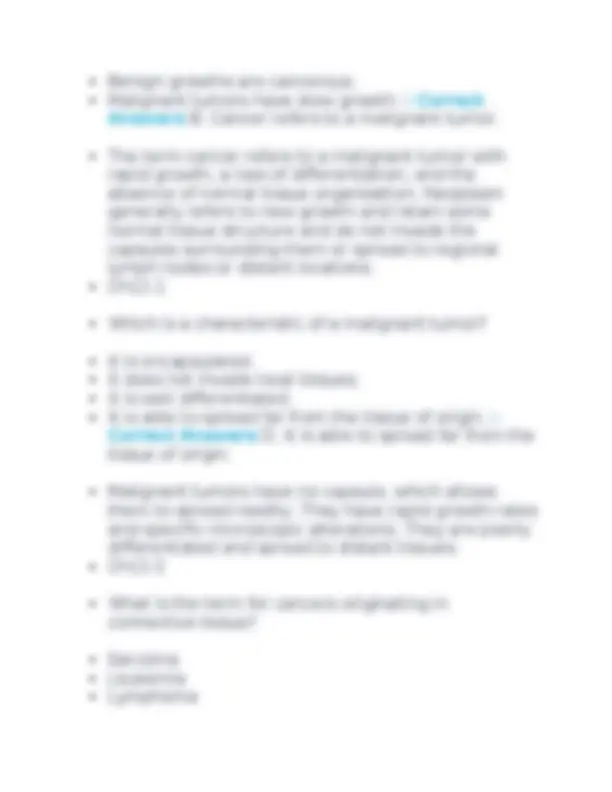

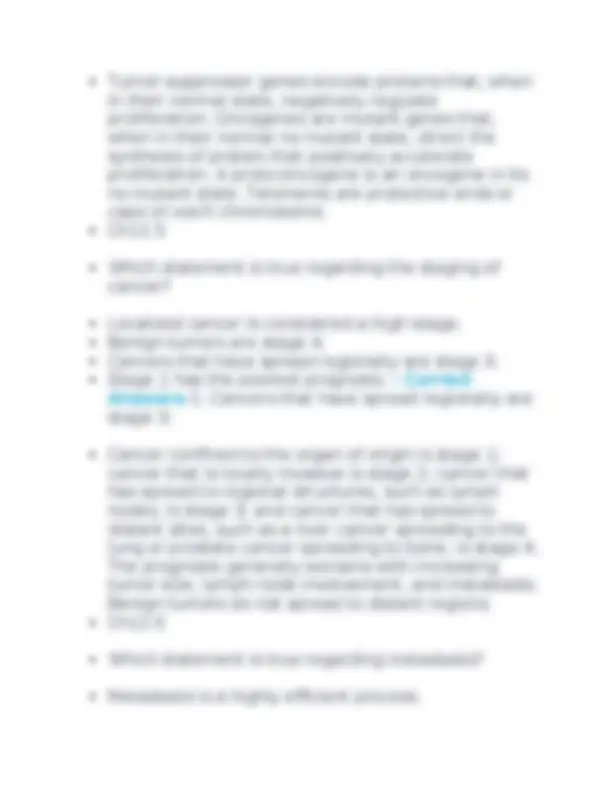
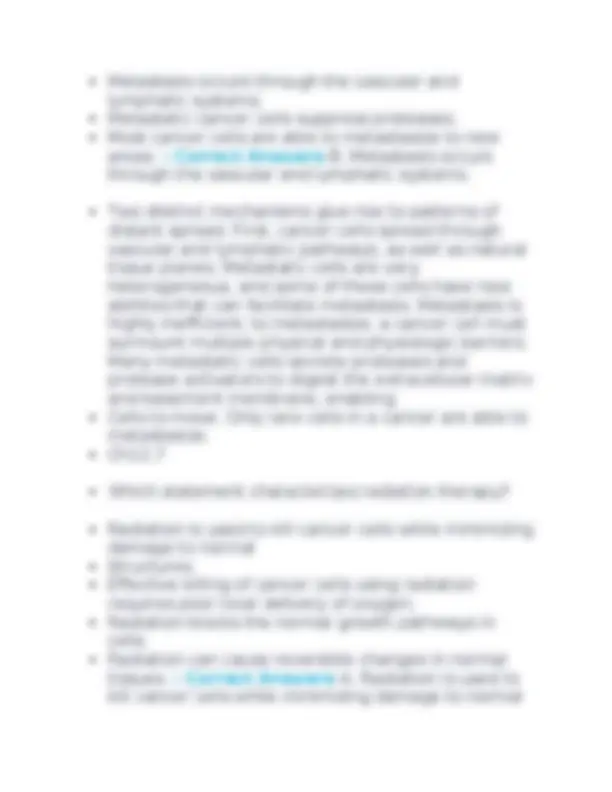
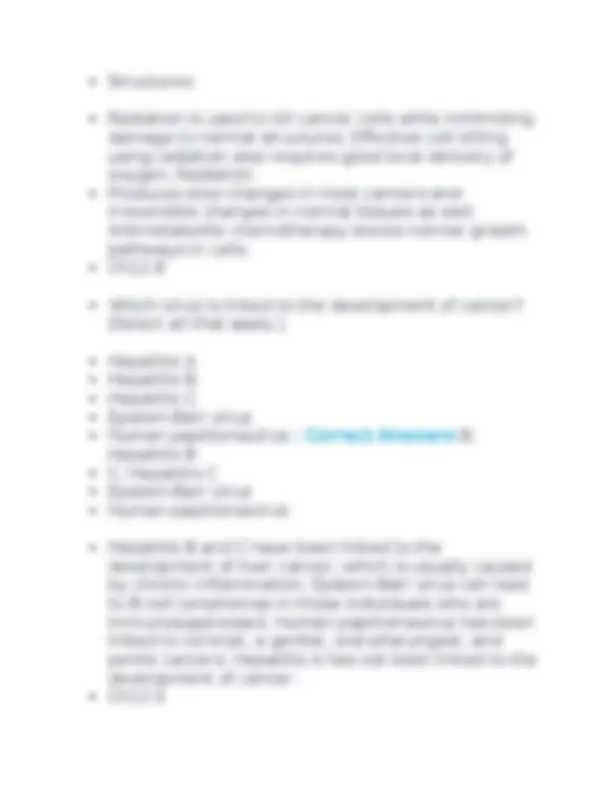
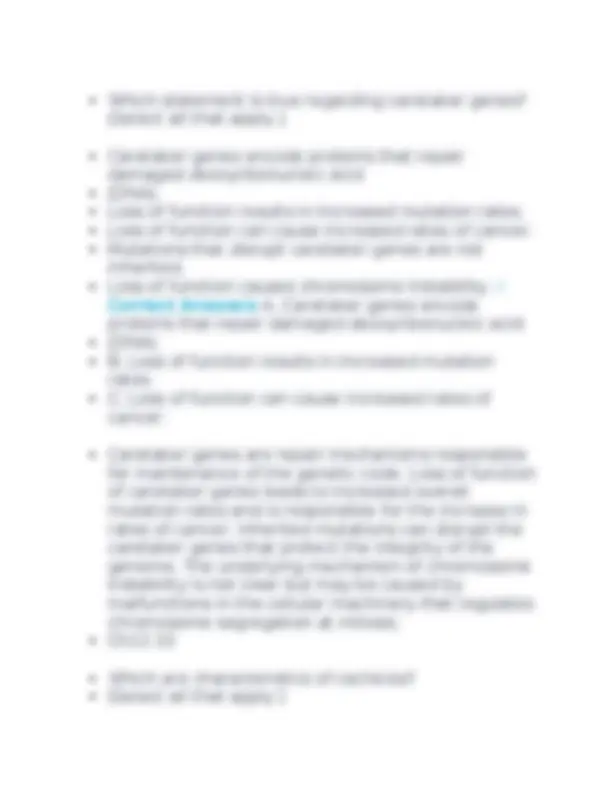


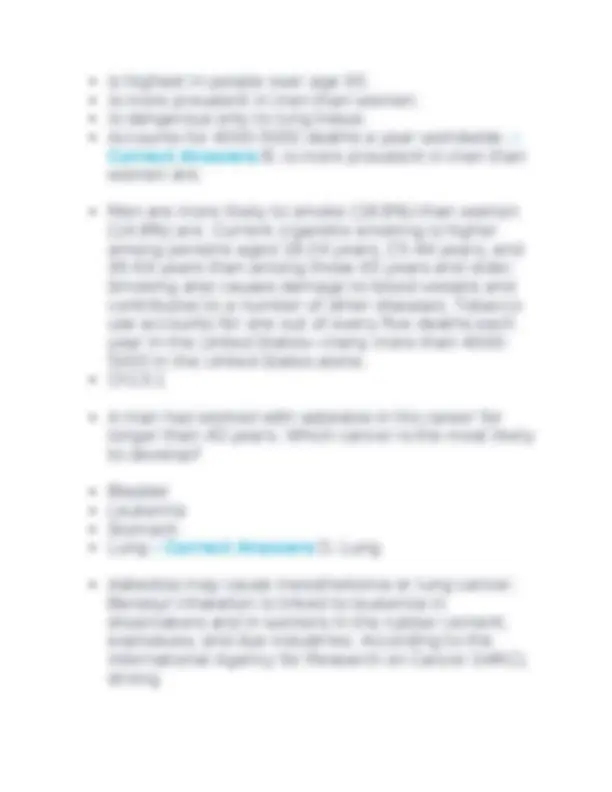



Study with the several resources on Docsity

Earn points by helping other students or get them with a premium plan


Prepare for your exams
Study with the several resources on Docsity

Earn points to download
Earn points by helping other students or get them with a premium plan
Community
Ask the community for help and clear up your study doubts
Discover the best universities in your country according to Docsity users
Free resources
Download our free guides on studying techniques, anxiety management strategies, and thesis advice from Docsity tutors
NUR612 Pathophysiology Final McCone & Hu ether assessment test with correct answers
Typology: Exams
1 / 338

This page cannot be seen from the preview
Don't miss anything!





























































































It is true that a eukaryotic cell Is smaller than a prokaryotic cell. Contains structures called organelles. Lacks a well-defined nucleus. Does not contain histones. - Correct Answers B. Contains structures called organelles. Eukaryotic cells contain organelles and histones; they have a well-defined nucleus, and are larger than prokaryotic cells. Ch01. The function of a histone found in a eukaryote cell focuses on cellular Division. Movement. Activities. Deoxyribonucleic acid (DNA) folding. - Correct Answers D. deoxyribonucleic acid (DNA) folding.
The histones are binding proteins that cause the supercoiling of DNA into chromosomes and do not affect cellular division, movement, or activities. Ch01. An organelle that is responsible for the metabolism of cellular energy is referred to as a/an Golgi complex. Mitochondrion. Endoplasmic reticulum. Nucleolus. - Correct Answers B. mitochondrion Mitochondria play a role in cellular metabolism, cellular respiration, and energy production. The Golgi complex is responsible for processing and packaging proteins from the endoplasmic reticulum, where they are synthesized. The nucleolus is a small, dense structure that contains the ribonucleic acid (RNA), DNA, and DNA-binding proteins. Ch01. Which statement best describes a desmosome? A desmosome is a barrier to diffusion. Desmosomes hold cells together by continuous bands. A desmosome is a communicating tunnel. Desmosomes function as a zona occludes. - Correct Answers B. Desmosomes hold cells together by continuous bands. The desmosome is a type of cell junction. The other two types include tight junctions and gap junctions.
Which statement is correct regarding cellular energy? Glycolysis is the building of sugar molecules. Oxidative cellular metabolism is a single reaction making adenosine triphosphate (ATP). Oxidative phosphorylation occurs in the mitochondria. Anaerobic glycolysis occurs in the presence of oxygen. - Correct Answers C. Oxidative phosphorylation occurs in the mitochondria. Oxidative phosphorylation occurs in the mitochondria. This is the mechanism by which the energy produced from carbohydrates, fats, and proteins is transferred to ATP. Glycolysis is a process that breaks down glucose molecules; it produces a net of two ATP molecules. Oxidation is a process during which a pair of electrons are removed and transferred. Oxidative cellular metabolism involves 10 biochemical reactions. Anaerobic glycolysis occurs in the absence of oxygen. Aerobic means in the presence of oxygen. Ch01. Movement of a solute molecule from an area of high concentration to an area of low concentration is called diffusion. Filtration. Osmosis.
Hydrostatic pressure. - Correct Answers A. diffusion. Diffusion is the movement of a solute from an area of high concentration to an area of low concentration. Osmosis is the movement of water down a concentration gradient from an area of higher water concentration to an area of lower water concentration. Filtration is the movement of water and solute through a membrane because of a greater pushing pressure on one side of the membrane than the other is. Hydrostatic pressure is the mechanical force of water pushing against a cell membrane. Ch01. Which is an example of an energy-releasing process? Anabolism Catabolism Substrate-induced reaction Second messenger system - Correct Answers B. Catabolism Catabolism is an energy-releasing process. The energy-using process is anabolism. A substrate is a specific substance that is converted to a product in the reaction. A second messenger is a "pass-it-on signal." This occurs when a first messenger activates a receptor that then triggers a pass-it-on signal. Ch01. Which describes an amphipathic molecule? It is permeable to water only.
Which are functions of a protein? (Select all that apply.) Pores or transport channels Enzymes that drive pumps Cell surface markers Synapses for cells - Correct Answers A. Pores or transport channels B. Enzymes that drive pumps C. Cell surface markers Proteins may act as transport channels, pores, cell surface markers, enzymes that drive pumps, catalysts, and cell adhesion molecules (CAMs), or they may act as the key components of ATP synthesis. Synapses are the connections between two nerve cells Ch01. Ribosomes are nucleoproteins that Are synthesized in the mitochondria and secreted into the cytosol. are synthesized in the cytoplasm. Consist of a network of cisternae. Synthesize a signal recognition sequence. - Correct Answers D. synthesize a signal recognition sequence. Ch1.1PPT Structure and Function of Cellular Components of Eukaryotic Cell The plasma membrane of a cell is
Permeable to water-soluble molecules' movement into the cell. Composed primarily of amphipathic molecules. Dimpled because of peripheral membrane proteins. impermeable to lipid-soluble molecule - Correct Answers B. composed primarily of amphipathic molecules Ch1.2PPT Structure and Function of Cellular Components of Eukaryotic Cell Which information is correct regarding neurotransmitters? Act on the cells that produce and secrete them. Act on nearby cells that also take them up and destroy them. Are produced by neurosecretory neurons and transmitted via the blood. Diffuse across the synaptic cleft and act on postsynaptic target cell - Correct Answers D. Diffuse across the synaptic cleft and act on postsynaptic target cell Ch1.3PPT Cellular Communication A nurse knows that active transport requires Receptors capable of recognizing and binding with specific molecules. A hydrostatic pressure gradient between intracellular and extracellular regions.
Epidural hematomas are a collection of blood between the inner surface of the skull and the dura. A contusion is a bruise or bleeding into the skin and underlying tissue. A subdural hematoma is a collection of blood between the inner surface of the dura and the surface of the brain. Subarachnoid hemorrhage is a condition in which a cerebral arterial aneurysm ruptures. Ch02. The possible diagnosis of shaken baby syndrome is supported when an infant brought to the emergency department is found to have which type of cerebral hematoma? Epidural Subdural Subarachnoid Avulsion - Correct Answers B. Subdural A subdural hematoma is associated with blows, falls, or sudden acceleration or deceleration of the head, such as the sudden movements that occur with shaken baby syndrome. Epidural hematomas are the result of a torn artery, often associated with a skull fracture. Subarachnoid hemorrhage is a condition in which a cerebral arterial aneurysm has ruptured. An avulsion is a tear or rip in the skin, resulting when tensile strength of skin or tissue is exceeded. Ch02. Which term describes a tear or rip of the skin with a jagged and irregular edge?
Abrasion Incision Laceration Incised wound - Correct Answers C. Laceration Lacerations occur when the tensile strength of the skin is exceeded, resulting in ragged and irregular abraded edges; an extreme example is avulsion, in which a wide area of tissue is pulled away. An abrasion results from the removal of the superficial layers of the skin caused by friction between the skin and the injuring object. An incision is a precise cut with an instrument that leaves regular clean edges. An incised wound is longer than it is deep and has distinct edges without abrasion. Ch02. Which term describes oxygen failing to reach the blood? Suffocation Strangulation Drowning Petechiae - Correct Answers A. Suffocation Suffocation occurs when oxygen fails to reach the blood. It is a subgroup of asphyxia injuries. Strangulation is caused by compression and closure of the blood vessels and air passages by external pressure on the neck. Drowning occurs when water or fluid alters the delivery of oxygen. Petechial are found on the neck of a victim who has been strangled. It is the result of compression of soft tissue and the breakage of blood vessels.
Altitude sickness occurs from blast injuries. - Correct Answers B. Pulmonary edema is the result of hypoxia and increased pulmonary hypertension. High altitude causes hypoxic injury. This hypoxia causes shunting of blood from the periphery to vital organs including the lungs and results in pulmonary hypertension. Caisson disease is often called the bends and occurs when divers ascend too quickly, resulting in a gas embolism. Gas emboli are formed when carbon dioxide and nitrogen, which are normally dissolved in blood, bubble out of solution. Blast injuries cause significant injury through the collapse of the thorax, the rupture of internal organs, and widespread hemorrhage. Ch02. Which form of necrosis is associated with tuberculous infections? Coagulative Liquefactive Fat Caseous - Correct Answers D. Gaseous Gaseous necrosis is normally found in the lung from tuberculosis. Tissues appear soft and granular and resemble clumped cheese (hence the name gaseous) and are surrounded by a granulomatous inflammatory wall; this pulmonary infection is caused by Mycobacterium tuberculosis. It is a combination of liquefactive and coagulation necrosis. Coagulative necrosis occurs primarily in the kidneys, heart, and
adrenal glands and is caused by protein degradation. Liquefactive necrosis commonly occurs in the neurons and glial cells. Fat necrosis occurs in the breast, pancreas, and other abdominal structures. It is cellular dissolution caused by powerful enzymes called lipases. Ch02. Which are causes of cellular injury? (Select all that apply.) Antioxidants Chemical agents Hypoxia Mechanical factors - Correct Answers B. Chemical agents C. Hypoxia Mechanical factors Injury to cells may be caused by chemical agents, hypoxia, free radicals, infectious agents, physical and mechanical factors, immunologic reactions, genetic factors, and nutritional imbalances. Antioxidants block the synthesis of free radicals. Ch02. Which are the most common risks of lead exposure in children? (Select all that apply.) Slowed growth Psychosis Reduced IQ Attention-deficit/hyperactivity disorder (ADHD) - Correct Answers A. Slowed growth
Which of the following statements is correct regarding pathologic hyperplasia? Produces abnormal proliferation of abnormal cells. Is an adaptive mechanism that enables organ regeneration. Increases cell size. May occur in response to growth factors - Correct Answers D. May occur in response to growth factors Ch2.1PPT Cellular Adaptation A nurse knows that free radicals may be produced by protein peroxidation. Metabolism of exogenous chemicals or drugs. Spontaneous decay of superoxide. Vitamins E and C supplements. - Correct Answers B. metabolism of exogenous chemicals or drugs. Ch2.2 Cellular Injury Which of the following is true about alcohol (ethanol)? Is metabolized via the microsomal P-450. Is primarily metabolized and excreted by the kidneys. Increases activation of methionine, an essential amino acid. Can produce hypermagnesemia with chronic use - Correct Answers A. Is metabolized via the microsomal P-
Ch2.3PPT Cellular Injury A nurse remembers that aging is associated with Reduced cross-linking of collagen. Reduced degradation of collagen. Increased cross-linking of collagen. Increased collagen synthesis. - Correct Answers C. increased cross-linking of collagen. Ch2.4PPT Aging and Altered Cellular and Tissue Biology A person with hypertension and heart failure has edema in the lower legs and sacral area. The nurse suspects this condition is due to a(n) Increase in plasma oncotic pressure. Decrease in capillary hydrostatic pressure. Decrease in lymph obstruction pressure. increase in capillary hydrostatic pressure - Correct Answers D. increase in capillary hydrostatic pressure Ch2.5 Alterations in Water Movement A person reports severe diarrhea for 2 days. The nurse understands this stimulates a(n) Reduction in aldosterone secretion. Reduction in renin secretion. Increase in antidiuretic hormone secretion.
A 17-year-old boy is admitted to the pediatric intensive care unit after surgery. The teen requires debridement of a wound on his sacrum (triangular bone at the base of the spine). His mother attributes this to difficulty in repositioning him because of his size. He has been in a persistent vegetative state for almost 4 years after suffering a traumatic brain injury as a result of a self-inflicted gunshot to his head. o The sacral area is covered with which type of tissue? Muscle Neural Epithelial Connective - Correct Answers C. Epithelial Ch2.9PPT Unit 1 The Cell - Case Study 1a A 17-year-old boy is admitted to the pediatric intensive care unit after surgery. The teen requires debridement of a wound on his sacrum (triangular bone at the base of the spine). His mother attributes this to difficulty in repositioning him because of his size. He has been in a persistent vegetative state for almost 4 years after suffering a traumatic brain injury as a result of a self-inflicted gunshot to his head o A large portion of the area is removed because of ischemia and cell death. The teen suffers from tissue. apoptosis. Necrosis. Catabolism. metabolism - Correct Answers B. necrosis
Ch2.10PPT Unit 1 The Cell - Case Study 1b An 86-year-old frail woman is admitted to the hospital for monitoring after sustaining a concussion due to a fall in the patient's home. The nurse performs the admission assessment on the patient. The nurse notices that the patient has generalized deteriorated muscle mass and decreased strength in the extremities. This condition is called Senescence. Autophagy. Apoptosis. sarcopenia. - Correct Answers D. sarcopenia Ch2.11PPT Unit 1 The Cell - Case Study 2a An 86-year-old frail woman is admitted to the hospital for monitoring after sustaining a concussion due to a fall in the patient's home. The nurse performs the admission assessment on the patient. The patient dies from an aneurysm and the nurse assesses the changes occurring in the patient's body immediately after death. The nurse notices that the patient's lower legs are turning purple. This is referred to as. Lager mortis. Livor mortis. Rigor mortis.